#second hand e rickshaw in delhi
Explore tagged Tumblr posts
Text
वंदे भारत ई-रिक्शा (Vande Bharat e Rickshaw): Price। Range। Features। Specification
vande bharat e rickshaw, वंदे भारत ई-रिक्शा, e rickshaw, e rickshaw price, e rickshaw market in delhi, e rickshaw price in delhi, second hand e rickshaw in delhi, e rickshaw business in hindi, second hand e rickshaw price in delhi, e rickshaw drivers in delhi, e rickshaw price in india, electric rickshaw, e rikshaw in under 1 lack, e rikshaw in 60000, loading e rikshaw in 60000, best e rickshaw…
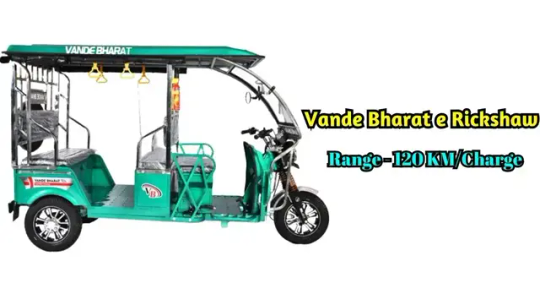
View On WordPress
#battery rickshaw#best e rickshaw battery in india#e rickshaw#e rickshaw business in hindi#e rickshaw drivers in delhi#e rickshaw market in delhi#e rickshaw price#e rickshaw price in delhi#e rickshaw price in india#e rickshaw&039;s in delhi#e rikshaw in 60000#e rikshaw in under 1 lack#electric rickshaw#loading e rikshaw in 60000#rickshaw#second hand e rickshaw in delhi#second hand e rickshaw price in delhi#vande bharat e rickshaw#वंदे भारत ई-रिक्शा
0 notes
Link
Better Payload Capacity
If the looks impress you, try and see its performance, with a high loading capacity and low maintenance, it has the potential of serving many tasks.
Smart Controlling System
Smart Control Systems can provide the most robust, versatile, custom made smart solutions of any type anywhere.
Driver Information System
Improve driving safety and efficiency by providing instructions to drivers aimed at improving their driving style.
#e rickshaw loader olx#electric garbage vehicle in india#e rickshaw loader price in india#bajaj e rickshaw loader price#e rickshaw loader price near me#e rickshaw for garbage collection price#mahindra e rickshaw loader price#e rickshaw garbage loader price near faridabad haryana#e rickshaw loader near me#electric tempo price in india#second hand e rickshaw loader in delhi#e rickshaw price in delhi on road#avon e rickshaw loader#e rickshaw price in faridabad#e loader price#e rickshaw loader price delhi#e rickshaw loader price#e-rickshaw loader#tata garbage truck price#electric garbage vehicle price#waste management electric vehicles#tata garbage tipper#electric garbage vehicle chennai#electric garbage collection#battery operated garbage vehicle#waste collection vehicle in india
0 notes
Text
“Arre, trust me, I am not at the Yamuna right now, we will not be catching any fish today,” Mahendar Haldar tells a vyapari, or fish buyer, on the phone. “Should I make you listen to the sound of the cooler to prove that I am at home?” he laughs.
Mahender, a fisher, and his six other colleagues are sitting in his house in North Delhi’s Bangali Colony, just a few minutes’ ride away from the Yamuna river. On a good day, they would all be stationed on the riverbanks from 7am to 6pm catching fish. But, today is not one of those days. “Abhi paani chal raha hai [the Yamuna is flowing heavily],” fisher Vishnu Haldar says, as he continues mending a fishing net to catch bigger fish, a bounty of the Yamuna’s monsoon waters.
The Yamuna’s deep waters flow silently, only interspersed by the lapping sounds of the river, and the chatter of egrets. Vishnu is right, the flow is indeed high—the Haryana government released Delhi’s legitimate share of 16,000 cusecs of water into the river on the same day. “For the last two years, this river bed has been completely dry. People used to play cricket here,” recalls Mahendar, pointing towards the gushing river.
The fisherfolk in this stretch of the river Yamuna find themselves stuck in a decades long battle between the Delhi and Haryana governments over releasing a fair share of the river’s water across borders. If the Haryana government releases too much or too little water upstream, fishing gets compromised in this stretch near North Delhi’s Wazirabad.
But the impact this has on North Delhi’s fishing economy is barely spoken of amidst the high octane political discussions over water sharing between the Haryana and Delhi state governments. In fact, water sharing isn’t the only government matter wherein Delhi’s 2,500 to 3,000 licensed fishers go unseen.
Delhi’s Master Plan 2041, a document released every 20 years by the Delhi Development Authority (DDA) envisioning the capital’s future land use does not mention the city’s fishers at all. The 9,700 hectares of the Yamuna floodplains—parts of where fishing activities are performed—are mentioned generously in the Plan. But, the Plan’s proposed vision of grass belts, greenways for cycling and walking, and riverfront parks for recreation, make no space for the people who have used the Yamuna’s resources to sustain their livelihoods for decades—like those employed in agriculture and fisheries.
“Dekhiye, ye paani ka kaam hai, [Our livelihood depends on what the water provides],” says Mahendar’s brother Krishna, sharpening a knife-like object that will help him cut the rope of the fishing nets. “Some days we go home after selling ₹5,000 worth of catch to a vyapari, sometimes we go home empty handed.” Mahendar and Krishna are thekedaars, or contractors, in North Delhi’s fishing business, where 26 other men work under them. Mostly second generation migrants from West Bengal, many here come from generations of fishers, having learnt the trade from their fathers. This fish—mostly Chinese Rohu and Kavai—is sold locally in North Delhi, just outside their colony, where the demand for fish seems to be high. All their catch is sold on the same day.
In this part of Delhi, fishing remains an activity dominated by men, where only very few women can be spotted on the Yamuna’s banks with a line and pole to catch a fish or two for their family’s consumption.
While the Yamuna river makes ends meet for half of the fisher’s year, some of the younger men resort to other economic activities for the remaining six months. Driving e-rickshaws and daily labour are a few options for them, while older fishers take this time out to rest.
But, up until 2015, fishers of Bangali Colony had an additional area to fish from just adjacent to Mahendar’s favoured fishing spot between Bangali Colony and Wazirabad—a large pond. “We would lease the channel from the government for a year for an annual charge between ₹80,000 to ₹1 lakh,” Mahendra informs. “The money we earned from the catch would run our homes, and what we earned at the main river bank was over and above that.”
But today, this stream is inaccessible to the fishers. It is now a part of the Yamuna Biodiversity Park developed by the DDA in 2015. This Park, complete with a sacred grove, a butterfly park, herbal garden, and wetlands, has become a choice spot for recreation and education for many in the city. But, it has excluded the fishers who depended on fragments of the same area.
“Residents from near-by areas came to jog along the stretch of the main river bank where we fish everyday,” says Krishna. “Those areas are anyway being used for recreation along with fishing, so what was the need of this park? Bilkul hi befaltu hai wo [the park seems to have no purpose].” That this singular purpose of recreation would continue to define the use of the area in the years to come disappoints the fishers, and their exclusion from the Master Plan worries them.
“In this core idea or vision of what Delhi should look like [according to the DDA], there is no presence of agriculture or fishing,” shares Rajendra Ravi associated with the National Alliance for People’s Movements (NAPM), who has also worked with the fishing communities of Delhi. What the city’s administration chooses to see—and not see—also impacts the governance around fisheries in Delhi.
“Fisheries comes under states’ Agriculture Departments. But in Delhi, there is no such department, or Minister,” shares Ravi. “What we do have is a Department of Development and a Minister responsible for it, under which fisheries, agriculture, rural development, and animal husbandry are listed.”
Illustrating how administrative territories stay murky, Ravi adds, “when the government occasionally provides monetary support to farmers in Delhi, I have found that it is disbursed from the Social Welfare Department, not from any of the funds of this Development Department.”
Delhi’s expenditure budget for fisheries throws up disappointing results. For 2020-21, a budget of ₹ 2.02 crores was estimated for fishing expenditure, which was revised to 56% lesser the same year. For this year, the budget allocated has further reduced by 31%.
“We got to know from the news that during the lockdown, a scheme for fishers in the country was announced,” says Vishnu, momentarily stepping out to light a beedi. “But none of us here have benefitted from it.” Vishnu is referring to the Pradhan Mantri Matsya Sampada Yojana (PMMSY) released under the Atmanirbhar Bharat COVID-19 Relief Package in September 2020. Amongst other objectives, financial assistance allocated to fishers under the scheme was promised to support fishers’ families during April and June, months when fishing is banned for fish to spawn. Gopal Rai, the sitting Minister for the Department of Development under the Delhi government, was out of station and unavailable to comment on the disbursement of funds.
“Pre-pandemic too, we did not receive subsidies or any other financial support from the Delhi government,” says Mahender as he waves to greet a group of Bihari men across the Yamuna, the only community other than Bengalis who fish in this stretch.
His colleague Bishwa agrees. “In villages in West Bengal and Andhra Pradesh, I know fisher communities get monetary support for equipment like fishing nets, and are even introduced to skills like rearing fish in ponds and cage culture.” Such financial support can be beneficial for fishers in areas where high investment costs are incurred. A new fishing net costs about ₹550/kg, adding upto ₹3 lakh for the amount of net they need to fish the river’s waters. Other operational costs also pile up—such as repairing their fishing boats, or buying new oars.
With the lack of government funding threatening the community’s prospects, Mahendar and other fishers here decided to take matters in their own hands. A few years ago, they attempted to form a registered cooperative of fishers in Delhi. “We thought this would give us an identity, that we could make pointed demands to the government as a cooperative,” Mahendar says.
But when the team went to the Department of Registrar Co-operative Society in Delhi, their request was denied. “Apparently, the officers there were shocked and asked where fishing could be done in Delhi, despite the fishers telling them of their decades long livelihood,” NAPM’s Ravi adds. “Currently, the very limited visibility that fishers have is only because of the lower level bureaucracy with whom the fishers deal with when they procure their fishing licenses. Only these officers interact with the fishers on a frequent basis. Higher up in the bureaucratic ladder, not many know of fisherfolk’s existence.”
Fishers close to Wazirabad in Delhi continue asserting their identity, but the rapidly developing city does not wait for them. On the contrary, the unwanted byproducts of development flow into their main source of livelihood—the Yamuna.
“At least twice a year, the waters in this stretch of Yamuna become completely dark,” says Bishwa, describing the toxicity of Yamuna. Mahendar adds, “in those times, if you wade through the water, your feet and thighs start itching.”
For these fishers who often have to wade into the river’s waters to spread out their nets, the itching is unavoidable. The group suspects that textile and leather mills in Panipat, about 90 kilometres upstream, are discharging their effluents into the river. Shoals of dead fish end up floating on the river when its waters turn dark.
“At the end of the day, the ecological services of agriculture and fisheries are connected, which is why fisheries need to be seen as an allied activity of agriculture,” explains Ravi. “Agriculture productivity will enhance with clean water, which is also needed for a healthy fish population. Having a thriving fish population in turn maintains the quality of water.”
The fishers here ensure that the fish population remains healthy. “Even when we accidentally catch the younger, smaller fish, we let them all go. We know that later, upon growing, they will be the ones that will help us earn our revenue,” Mahendar says. “Which is why, when juveniles end up dying due to the polluted waters, it really makes us frustrated.”
Highlighting a “people river connect”, earlier this month, Mei Bhi Dilli, a citizen’s collective to make planning in Delhi more inclusive and representative, discussed demands that it had presented to DDA specifically for a floodplain zone, or “Zone O”. They asked the Master Plan to identify and map farming settlements in Zone O and integrate existing farming and fishing practices into the Plan after consulting with the communities here.
“We want to be identified and want the government to recognise us as the beneficiaries of various fisheries schemes available,” Krishna says. “There are so many ponds in Delhi, why can’t some of these be developed for fish farming?” Krishna’s colleague Vishnu chimes in.
A pair of white herons fly low on to the river bank. “You come in the winter, and you’ll see so many more species of birds!” says Krishna, as he begins listing down species of bird names in Hindi, a lesser-known set of ecological knowledge that might not get transferred to the next generation. None of the fishers here want their children to fish for a living.
Vishnu, Mahender and their colleagues might be the last generation of fishers in Delhi. This early demise seems to be accentuated by a growing city that has barely recognised them through the years, and by skipping them in the 2041 Master Plan, continues to neglect them in the capital’s future.
5 notes
·
View notes
Link
India’s Economy Exits Deep Recession as Fledgling Recovery Strengthens NEW DELHI — After plunging into one of the worst recessions of any major economy, India is showing signs of a modest comeback. But that recovery is uneven, and the country is still struggling to find ways to sustain growth. Its service sector is vulnerable, and the vast informal economy — which employs farm hands, day laborers, rickshaw drivers and many millions of others — remains weak as well. India’s economic output grew 0.4 percent in the third quarter, which ended in December, compared to the same period a year earlier, according to economic data released by the Indian government on Friday. The figures show that India has emerged from a recession, which is generally defined as two consecutive quarters of economic shrinkage. The economic turnaround is good news for the government of Narendra Modi, the prime minister, and for Indian households that have struggled with the impact of the pandemic on the country and on the global economy. But that rate is still slow compared to previous years, when the economy has grown at a pace of 6 percent a year or higher. Growth had already been stumbling for the two years before the pandemic hit. The challenge for the government will be to find opportunities for a relatively young and aspirational population. Economists said that the fledgling recovery was driven by services, agriculture, construction and some sectors of manufacturing. The service sector — especially financial and professional services — has done much better than expected, said Priyanka Kishore, head of South Asia at Oxford Economics. “The broadening of the recovery, alongside the solid growth momentum, creates upside risks to the 2021 growth outlook,” she said. “However, there are reasons to be cautious in the near term, given the slow start to vaccination, spikes in cases in some states and the threats from new variants.” Last spring and summer, India imposed one of the world’s strictest and longest lockdowns, allowing only essential services to function. That brought the economy to a near standstill and left many people unemployed, especially workers who are part of the country’s enormous informal economy. India’s economy was one of the worst performing among major countries last year, contracting 24 percent in the first quarter, despite expansive government spending. In the second quarter, it contracted again, by more than 7 percent. For the moment, though, the pandemic appears to be largely under control, and India has emerged from its lockdown. New virus cases have dropped to around 15,000 per day, compared with nearly 100,000 last fall. Virus deaths have dropped to around 100 per day, compared with more than 1,000 during the worst period of 2020. But cases are rising again in some parts of the country, including the financial capital of Mumbai. In recent weeks, in many Indian cities, life has returned to near normal. Restaurants and bars are crowded over weekends. Movie theaters, swimming pools and gyms have reopened. Street markets are thronged with people shopping for weddings and festivals. And some schools are finally back in session. India produces millions of doses of vaccines each day, and the world’s largest immunization drive is fully underway, though it is restricted to frontline workers. More than 13 million people have received at least one dose of the vaccine. The government has announced that starting on March 1, private hospitals will also be allowed to administer the vaccine to anyone over 60 years or those over 45 years old with certain medical conditions. Experts hope that as the vaccination rollout picks up pace, it will blunt the effects of a possible second wave and put the economy back on track. But the data shows an uneven recovery, with small businesses facing the brunt of the downturn. “Large companies have seen a major increase in their profit. This shows up in the G.D.P. numbers. In the two consecutive quarters, the listed companies have made unprecedented record profits, ” said Mahesh Vyas, chief executive of the Center for Monitoring of the Indian Economy. “They are grabbing markets at the expense of small-scale industries. So small- and medium-size companies are not able to survive.” But the G.D.P. figures fail to give a complete picture because they do not reflect the effect on the informal economy, said Arun Kumar, an economist at the Institute of Social Sciences in New Delhi. “This data does not account for the unorganized sector at all, and that is the sector which was hit the most,” he said. “The organized sector in e-commerce is gaining at the expense of brick-and-mortar stores.” The unorganized sector excluding agriculture employs nearly 50 percent of the work force and contributes more than 30 percent of the G.D.P. Various agencies forecast that the Indian economy will grow more than 10 percent in 2021. But the Indian government, which had been predicting a higher growth rate for the last quarter, now says that the economy will have shrunk by 8 percent for the financial year ending March 2021. Jeffrey Gettleman contributed reporting from New Delhi. Source link Orbem News #deep #Economy #Exits #Fledgling #Indias #Recession #recovery #strengthens
0 notes
Text
A week after Delhi riots, victims stare at an uncertain future
New Post has been published on https://apzweb.com/a-week-after-delhi-riots-victims-stare-at-an-uncertain-future/
A week after Delhi riots, victims stare at an uncertain future

Gali No. 4 of Khajuri Khas Extension in Northeast Delhi is charred to the bone. Mukeem, a middle-aged owner of a furniture store, is searching through the debris of a building that was both his home and shop. He claims he has lost properties worth Rs 1 crore. Sarkari muaavaza (official compensation), whatever be the amount, would mean nothing, he says, considering the damage he and his family have suffered.
“My home and warehouse were first looted and then set on fire,” he says, adding that the attack was wellplanned, with many carrying cutting tools and keys to break open doors and shutters. He now stays with his relatives in nearby Chandu Nagar, with no clue of what lies ahead.
It is a week since riots spread across Northeast Delhi — the worst the capital has seen since the anti-Sikh pogrom of 1984 — and what is left are frightened people, burnt-down lanes, abandoned homes, an uneasy calm and an uncertain future. Mohammed Asad, a student, leads us to the home of his uncle, Mehboob, who rents out space in his covered parking lot. All 23 vehicles parked there, including two auto-rickshaws and Asad’s Royal Enfield bike, are reduced to a mangled heap of metal. “I had paid only three instalments of my bike. What remains is the iron relic of my pride,” says Asad.

Sundar Lal has opened his grocery shop in Chand Bagh after a week.
Their homes burnt down and papers lost, many residents fear they would face difficulties in claiming insurance. ET Magazine counted at least 20 charred houses in the single by-lane of Khajuri Khas Extension where Mukeem and Mehboob live. Saira Bano, holding her three-month-old daughter Anisha, weeps as she says, “As our house was burning, there was no way we could take the stairs. From the fourth floor, we dropped our child into the hands of someone on the second floor. From the second floor, we again dropped her to someone on the ground floor. Then we ran for our lives.”
Many had escaped by the skin of their teeth. “We saw the rioters coming. So we shut our shop and went upstairs. But the rioters broke open the shutter and set everything on fire,” recalls Mohammed Jamid, who runs a bakery at Chand Bagh with 12 other family members, including his sons and daughters-in-law. What remain are sooty walls and burnt remains of the machines and the display counter. He estimates the losses of his movable assets to be about Rs 12 lakh.
ANI

A paramilitary soldier stands guard as shops open in riot-hit Jafarabad on Saturday.
In Chand Bagh, one of the violence-hit neighbourhoods, several shops and homes are burnt and by-lanes are strewn with ashes and debris.
Sunder Lal has opened his grocery shop after a week. So has Sujan Singh. Sundar, 65, says he saw rioters burning one shop after the other in just two hours on Tuesday evening. He points towards the shops — Sasaar Sweet House, Jain grocery shop, a Vaishnav dhaba and Bunny ice cream shop.
In nearby Maujpur, SK Sharma is reading his morning newspaper outside his fodder shop. “If Muslims have lost their homes, so have Hindus. It is time to count our losses and get back to work,” he says. Everyone, Hindu and Muslim, has a harrowing story to share. It also often reveals the mistrust and divide between the two communities.
A few Hindus in Chand Bagh allege they saw councillor Tahir Hussain, who has recently been expelled from the Aam Aadmi Party, pelting petrol bomb and acid from his multi-storey building, while some Muslim residents claim he is a saviour.

Mohammed Jamid, who runs Nagina bakery in Chand Bagh, and daughter-in-law Rehana.
“I lost the keys of my sweet shop on Monday when rioters came to our area and wreaked havoc,” says Sujan Singh, pointing towards Hussain’s home. But Singh says it’s now time to leave behind the horror and return to business.
Agrees Muhammed Sabit, a Muslim manager at Khullar Tempo Transport Service, owned by a Hindu: “Both sides have suffered. Had police been deployed on time, I feel the losses would have been bare minimum.” He was the first to open his shop on the main Bhajanpura road on Saturday morning.
They are trying to pick up the pieces and piece together their lives. But the wounds are still raw and the losses have yet to be counted.
if(geolocation && geolocation != 5 && (typeof skip == 'undefined' || typeof skip.fbevents == 'undefined')) !function(f,b,e,v,n,t,s) if(f.fbq)return;n=f.fbq=function()n.callMethod? n.callMethod.apply(n,arguments):n.queue.push(arguments); if(!f._fbq)f._fbq=n;n.push=n;n.loaded=!0;n.version='2.0'; n.queue=[];t=b.createElement(e);t.async=!0; t.src=v;s=b.getElementsByTagName(e)[0]; s.parentNode.insertBefore(t,s)(window, document,'script', 'https://connect.facebook.net/en_US/fbevents.js'); fbq('init', '338698809636220'); fbq('track', 'PageView');
Source link
0 notes
Text
Best Experience at Jaisalmer Trip by Car - Work & Leisure
‘A journey is best measured in friends, rather than miles’, Tim Cahill says so; and this is exactly how I feel at the end of our road jaunt from Delhi to Jaisalmer. Newfound friends in a new city, concocted in my life like the fragrance of freshly brewed coffee that infuses in one’s system every morning. Hahahaha….a poor simile, I know! But as winter is deserting Delhi, I am clinging to my last few sips of hot coffee.
Four families met during Dussera (a larger than life festival in India during the monsoon season) and became so genial that a road trip to Jaisalmer did seem like the most obvious thing to do. A thousand kilometres from Noida (when you take the NH 8) is definitely no sweat unless I tell you that we had two very elderly couples accompanying us! Oh yes! So, there was the enthusiastic us, our animated kids, and the high-spirited parents- all excited about setting their foot on the golden sand.
Six couples and 3 kids were comfortably packed in Mahindra Scorpio, Maruti S-Cross and Hyundai Elantra-Hyundai Elantra taking away the award for ‘The Car of the Trip’ for giving an excellent mileage of 20 plus on the highway when driven at the speed of 120 to 140 KM per hour.
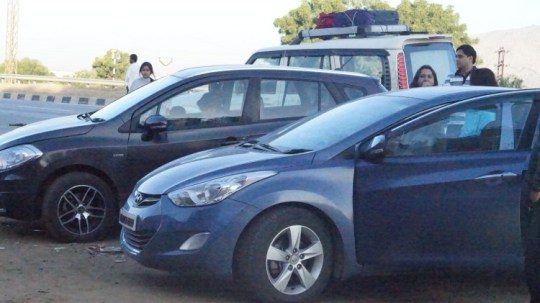
We started our mini escapade at 12 midnight from Noida, sector 78. You can quite well imagine why we chose to start at midnight; it was obviously to avoid the rush of traffic during the day. Yes, we avoided the day traffic rush, but the trucks and lorries on the National Highway did not make it any easier. So, may I suggest that starting early in the morning at 4 AM may be a better idea, instead!
While some of us had filled ourselves from home, some were still to have their dinner and hence we decided to stop for a quick grub. Unfortunately, for the starving souls, that stop didn’t happen till we covered almost a 100 KM.
I will tell you where we made a mistake here;
We did not curb at Gurgaon in a haste to get rid of the traffic caused by the trucks on the Highway. It didn’t help at all. Instead, we went on looking for the right place to dine with family but found none. Finally, we ceased at a Dhaba but witnessed some rift between two men and ran away. At 3 AM in the morning we eventually halted at another highway joint and were treated with the yummiest aloo parathas I have ever had; you can also take this as a review of a hungry and tired soul
Takeaway lesson: If you plan to start at night, it will be wise to fill yourselves up. Halting at the highway after midnight did not seem like an accommodating idea to me.
Our next pause was at 7 AM in the morning for breakfast and then 11 AM for tea; another one for lunch and few many brief halts. Every break was a fun of a different kind, with us seizing the kitchen to make personalised delicacies for our ever-food-craving appetites. Madness??? Oh yeah!
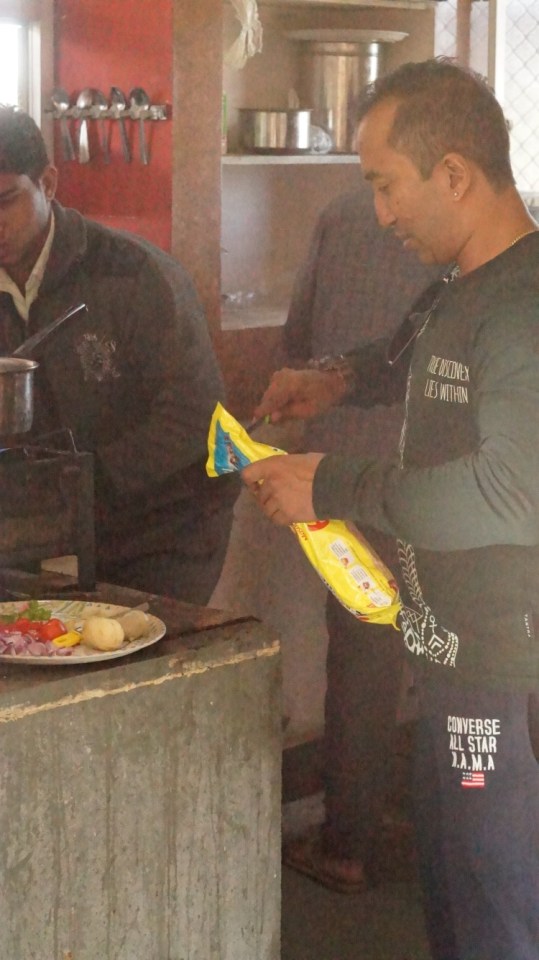
Our man at work
The drive from Noida to Jaisalmer took 20 hours due to our numerous stops. But we took this as an opportunity to engulf the beauty that our journey bestowed upon us. The roads and the subtle panoramic view on both sides of it were something one could get lost in. We have, of course, locked the experience in the countless pics that we clicked.


From the road!
Royal Haveli at Jaisalmer is where we stayed for the first two days.
Rewind: Fifteen days prior to our trip, all heads attacked the various travel websites, trying to find the best place for stay. Some reviewed the places from the point of view of rating, some were dogged by luxury ambience while the others looked at moderate pricing with a tasteful stay. ‘Moderate pricing with a tasteful stay’ got an upper hand over the rest and Royal Haveli, of all the hotels in Jaisalmer, had the pleasure of hosting us :)

On a serious note, Royal Haveli in Jaisalmer is a perfect example of a decent stay. It is no real Haveli turned into a hotel property. It’s a hotel that looks like a mini Haveli – colourfully and tastefully done, with commendable service. The food was good; veg available round the clock and non-veg available on request. No hot water at night. Provided in buckets when asked.
What you may not like: Tissue Paper in bathrooms only available on request.
USP: laudable service
Since we reached Jaisalmer at 7 PM on 11th night, we didn’t venture out that day. While we ladies were busy feeding the little ones, and putting them to sleep, the men headed to a famous shop in the city to drink lassi mixed with bhang (hemp). They were nice enough to get a glass of ‘bhang lassi’ for 4 ladies to share. You are right, one small glass for four of us! Arrgg! But for the sweethearts that we are, we let it go! We spend the rest of the night on the terrace of this mini Haveli Hotel offering a nocturnal yet enchanting view of the Jaisalmer Fort, chatting and making merry!
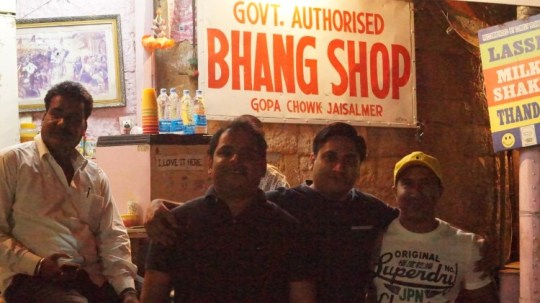
The tiring drive did not keep us in bed for long the next morning. We were up and buzzing by 8. While some of us were busy decking ourselves for the day ahead, two of our friends found the best dal kachori and jalebi in Jaisalmer and had it packed for our breakfast. A delicious way to start the morning, indeed!
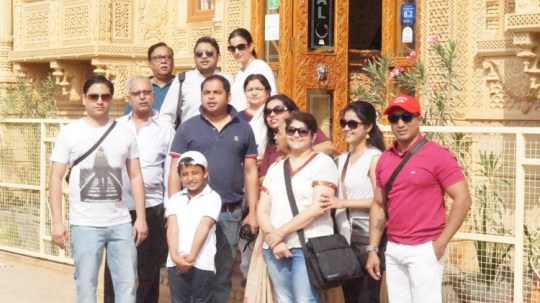
The gang! Ready for the exciting day ahead!
Our first stop that day was at the Jaisalmer war museum; a place every Indian must visit. A museum may sound boring, but the candid captures of our brave jawans smiling with heavy guns in their hands are anything but inspiring. Every letter written by the soldiers to their families brought me close to tears. There is also an elaborate display of weapons and tanks captured during wars, for those who love machinery.

Our next terminus was Longewala border which is about 110 km from Jaisalmer. I had heard once that sometimes the road to the destination is more alluring than the destination itself; so, it was! The way to Longewala War Memorial which is 15 km before the India-Pakistan border, had me lost in its curves and twists. I never did imagine that being in Rajasthan meant driving on camel’s back; not literally, of course! The 110-km stretch was beautiful with empty roads analogous to the humps on camel’s back. There was only golden sand on either side with short shrubs looking up to the sky as if asking for less sunshine and more rain. Hailing from a green hill station in north-east India, this definitely was a view to die for.
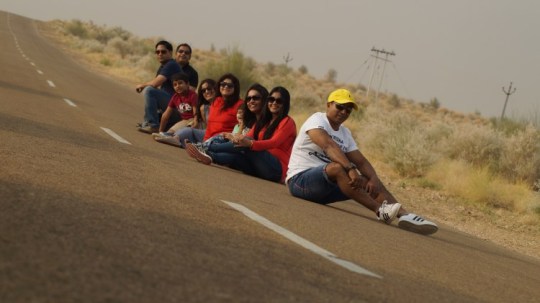
Note: There is no food stop on the way. Please fill yourselves up before you start from the city.
After a halt at the border for an hour or a little more, we continued to drive towards Tanaut Mata’s Mandir (temple). A very famous temple that is said to have withstood the test of time and explosives too, during the war. We reached the temple right in time to attend the evening prayers. A soul filling ‘aarti’ by the army jawans was simply out of the world. It engulfed us completely and we left the temple feeling heavenly and connected to the all-mighty.
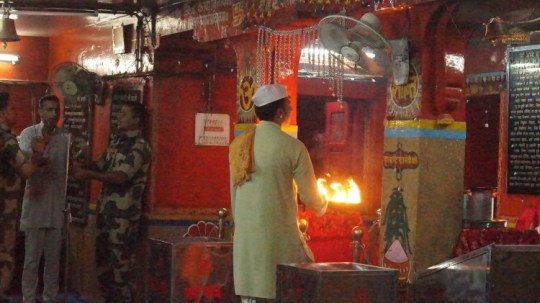
We made our way back to the hotel in a sombre frame of mind reliving every moment of the day spent so well with the people we felt so close to!
On the second day, we were all geared up to roll in the golden sand under the diminishing amber sunlight. But before that, we had to visit the famous ‘Sonar Killa’. We spend half of our day marvelling over the Jaisalmer fort. Beautifully and intelligently built, no doubt this magnificent structure has stood the test of time!

A glimpse of the fort
By the end of our fort exploration, our stomachs were screaming for food. Our big boys had done their homework and escorted us to Gaji’s Restaurant. Don’t miss it! Pleasing ambience with a scrumptious continental spread. But what I personally enjoyed is the auto-rickshaw ride to the Gaji’s. Rickshaws with an open back to sit were new to me, and we all made the best of it.

We were finally ready for the sand. As soon as we were done with the lunch, we packed ourselves into different cars and headed to Camp-e-Khas, our paradise in the desert. Jammed in an all-girls car driven by one of our hotties, we were the first to reach the destination. Threw our bags at the camp and just boarded the Thar (jeep), all ready and waiting to escort us. After a long time, felt the adrenaline rush as the jeep went flying on the sand. Dune bashing it’s called, I guess. Whatever it was, it is worth every second! As planned, we witnessed the sand turn amber under the setting sun. A camel ride was what the children were looking forward to. Their shrieks and shrills made every bump exhilarating.
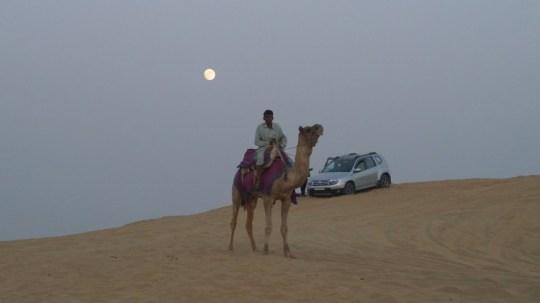
After an hour at the dessert, we headed back to the camp. Camp-e-Khas had organized ‘khas’ or special dinner for us. The dinner was served at the mini amphitheatre with Rajasthani folk song and dance performed by the local entertainers. The men were their best selves dancing away to folk music with the two performers. Well, it was obvious that they found the dancers irresistible.
As the jocund evening came to a closure, we realized that our enthralling trip too was about to end. But we could not just let it be enthralling, we had to make it crazy too. We put the children to sleep and at 2 AM booked a jeep and went dune bashing back in the desert. It was the best experience of the entire trip. Zooming away under the moonlight with the chilled breeze slapping our face, we screamed and yelled our daily stressful routine out of our systems. Till 3 AM we rolled in the desert sand and sang songs. To our luck, a tea seller appeared from nowhere and treated us to the much-needed ginger tea. That one hour made our trip truly extraordinary!
Note: On our way back the next day, we stopped at Kafe The Kaku for lunch. Amazing food with a pleasant milieu. It occupies a small part of the Jaisalmer Fort giving away a mesmerizing view of the city and the sunset in the evening.

Sunset from ‘Kafe the Kaku’
It was late evening when we started from the ‘Kafe’ back to Delhi with a bag full of thrilling and adorable memories :)
0 notes
Text
Official Blog: www.bornomadic.com
Isn’t it true that everyone wants to travel? Yes, but money plays an important role in making this decision. Therefore, I’ll am sharing my journey how you can travel cheaper, longer and safer in Sri Lanka 🙂
How to travel Sri Lanka under 500$?
Trust me! You can travel even cheaper. I focused primarily on three things.
(a) Accommodation: If you chose the right accommodation. You would save a good money which can be used tor food or transport. So, I used websites like www.airbnb.com, www.booking.com, and www.agoda.com for places to spend the night. Keeping the expense as low as 10$ at most of the places. However, there were a few places where I had to pay 15$ but not beyond that. Also, I searched for homes that provide free breakfast, free Wi-Fi, and free laundry.
(b) Food: Make sure that your accommodation provides a free breakfast. Then, you would have to just focus on lunch and dinner. I chose inexpensive restaurants but decent ones. Being an Indian I thought that I would be able to get accustomed to Sri Lankan food. But it turned out to totally different. I was unable to develop the taste for the food. However, there were certain dishes that I did like. (i) Rotti – very similar to India chapatti (bread) but with filling. The stuffing could be chicken, banana, pineapple, egg and the list goes on and on. (ii) Kuttu – it is a mix of chapatti with vegetables, chicken (iii) Hopper – is a bowl-shaped pancake-like dish. It’s made of rice.
Suggestion: 1 Litre Water bottle in Sri Lanka costs around 80-100 LRK (approx. 1$). So, what you can do is a carry a water bottle or two always so that you don’t have to buy one. I re-filled them from places where there were water purifiers installed. It saved good 50$ or so for me during my entire trip.
(c) Transport: The whole country is very well connected through its bus and train system. You may have to change a bus or two to reach your destination at times. But it would definitely save some cash. The Auto-Rickshaw’s (Tuk-Tuk) charge is pretty high. So, I avoided this medium. However, I did take an Auto-Rickshaw (Tuk-Tuk) once as I had to leave early to climb the Adam’s Peak and I had no other option. For trains, I would suggest taking a second class ticket as it is reasonable and the seats are fairly comfortable.
Note: Purchase a SIM from a local shop outside the airport. I made a mistake by purchasing it from the airport costing me 1300LRK (250 minutes international, 500 minutes local, 3GB of data). Later, I got to know you could get a similar deal for 300LRK (500 minutes local, 2GB of data. This is a better deal in case you don’t need international minutes.
I travelled as an “unplanned traveller” without any itinerary. However, I was able to cover as much ground as I can in these 15 days.
Colombo | Kandy | Dambulla | Nuwara Eliya | Maskeliya | Ella | Mirissa | Galle | Anuradhapura | Jaffna | Colombo
My Journey
I carried a journal during my trip to keep the notes of the trip and also a count of my daily expenses. I would share my entire trip here including the expenses occurred. Hope this would provide you with a fair idea on how you can travel cheap, safe and long.
Day 1 (New Delhi – Bangalore – Colombo – Chennai)
My flight’s scheduled departure from New Delhi was 8.35PM but it got delayed by the half-hour. This delay caused another problem for me. It was a connecting flight. I had to board another plane from Bangalore to Colombo and go through the immigration and security checks. All this was time-consuming I felt I would miss the flight. The boarding time was 12.30AM and I reached the queue for immigration clearance at 12:20 AM. Thankfully, the JetAirways executive expedited the process, sorting the issues with airport authorities. And finally, I was in the place.
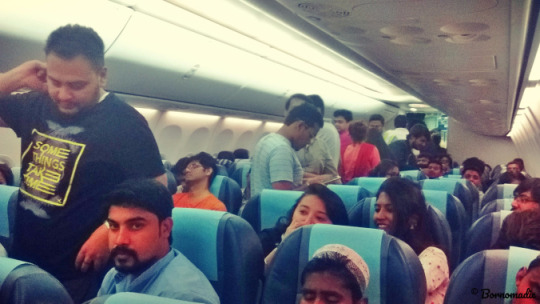
Took a moment to capture all the commotion in the plane after the drinks were served
I was all relaxed and wanted to take a nap. But my luck was not with me. I have never seen such a scene in an aeroplane. There were around 90 odd people travelling together for some kind of a meeting in Colombo. After the liquor was served the plane completely turned into a cheap club. I cannot describe the scene but reminded me of this movie ‘Soul Plane’, if you haven’t watched it – Please do!
Anyways, I looked forward to my amazing trip. I was eagerly waiting for the plane to land at Colombo. I was just an hour from the foreign land. Once the place flew over, my eyes experienced a mystical view from the aeroplane window. The whole city glittered by the deep blue sea, it seemed as thousand stars in the sky and our plane was flying upside down. All this anticipated my excitement. We were getting closer to the ground, preparing to land. When suddenly, the captain throttled the plane flying us back above the clouds. Everyone started looking at each other in amazement.
And, an announcement happened “There has been a technical problem at the Colombo Airport, so we are going back to Chennai”. Now, you can image how happy I was.
Day 2 (Chennai – Colombo – Kandy)
In an hour we were at the Chennai Airport, refuelled and flew again for Colombo. The plane landed around 5 AM and I was sure that no way I would be able to catch the train for Kandy for which I had made an advance payment. Yes, I did miss it. Immigration and baggage collection took another hour. Finally, I was out of the airport around 7 AM.
Suggestion: The best way to reach Colombo Fort Railway station is to take Bus No. 187. It takes an hour to get to the fort and charges only 120LRK. If you opt for a tuk-tuk it may charge a hefty sum like 1000LRK or more.
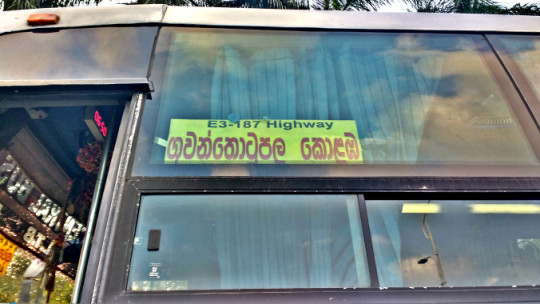
Bus E3-187 from Airport to Colombo Fort
It’s a decent AC Bus. But, it will not move until all passenger seats are full. So, one has to wait for a while. In my case, the bus left within 30 minutes. I reached Colombo Bus stand around 8.25 AM, from there the Colombo fort is just a 10 minutes walk.
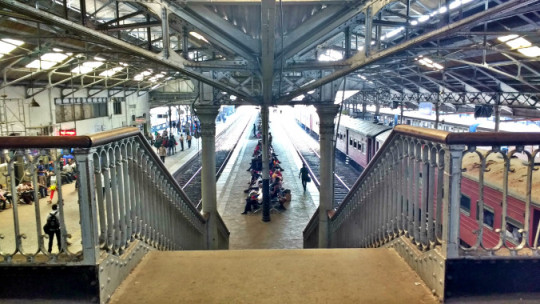
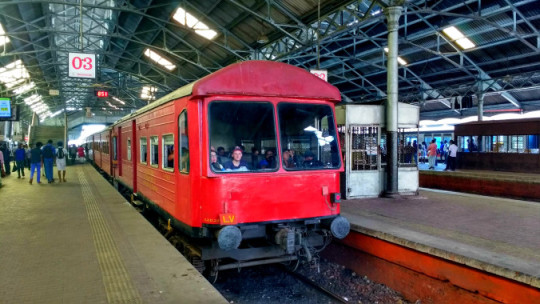
I reached Fort a late as I had planned. Therefore, I could only get the ticket for the train which was scheduled for 10:30 AM (Kandy Rajdhani). It was a 2nd class ticket costing 190LRK. I had to wait 2 hours for this one. So, I roamed around the station appreciating the beautiful architecture laid by the British, still standing strong. Clicked few pictures of the trains passing by.

The 4-hour journey from Colombo to Kandy is breathtaking. The rides take you through the lush green foliage of the banana and the coconut trees, symmetrically step farmed paddy fields, petite settlements, and massive tunnels, providing the view of the hills that is too incredible to imagine.
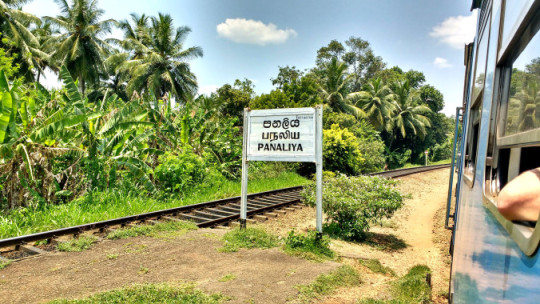
Any traveller would love to experience this enormous exhibition of the countryside. I was tired and deprived of sleep but I deliberately kept myself awake so that I don’t miss this abundance of beauty. The only drawback is that the train stops every 30 minutes or so.
Finally, I reached Kandy, around 2.30 PM. I had booked a place to stay for 2 nights which was at a walking distance from the railway station.
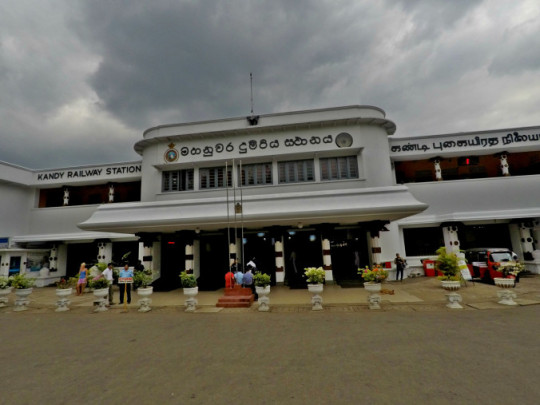
After walking for around 15 minutes I was at the ‘Clock Inn, Kandy‘. I chose to stay in these capsules as this was something distinct that you don’t get to see every day.
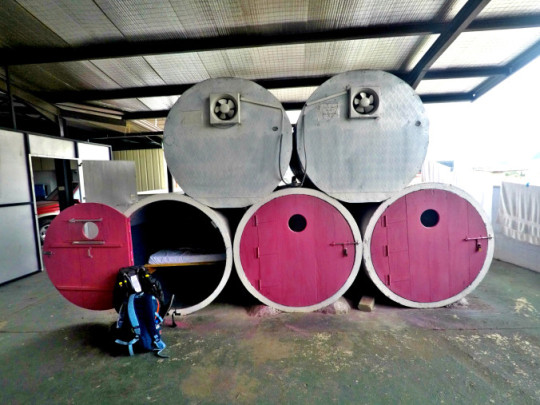
Thinking, I have few hours in hand before the sunset. I thought of visiting places nearby. I could see this huge ‘White Buddha’ statue from my capsule. So, I took a shower. I picked a map from the reception and started walking towards this Buddha Temple.
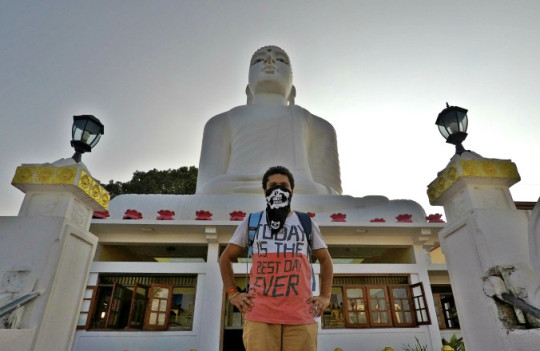
Enter a caption
I reached the Big White Buddha temple after hiking for 45 minutes from the hotel. The temple is beautiful and one gets to see the whole city and the lake from this elevation. However, there is an entry fee to the temple (250LRK). You may also be asked to provide donation by different people within the premises ( I ignored those guys). However, I did pay 20LRK to this shop owner who took care of my shoes when I was in the temple.
I walked down the hill and sat on a bench by the Kandy Lake to see the day end. It was beautiful.
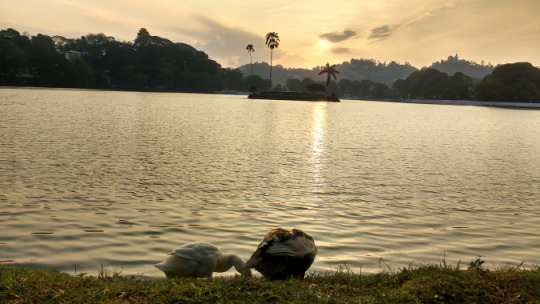
By now, I was starving so I hopped into this local restaurant and requested for an authentic Sri Lankan cuisine. The owner suggested me to try Hopper – Plain and Egg. And trust me “it was delicious”.
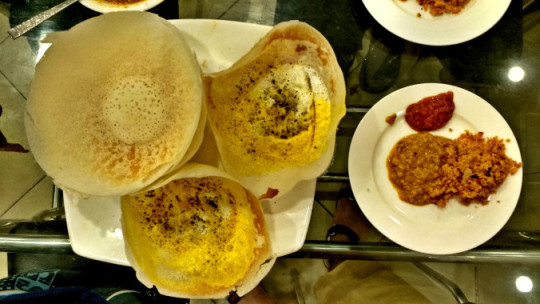
Day 2 Expenses – 4265LRK (28$) (a) Local SIM – 1300LRK (b) Bus from airport to Fort Colombo – 120LRK (c) Train to Kandy – 190LRK (d) Snacks in the train – 140LRK (e) Water Bottle in the train – 50LRK (f) White Buddha Entry Fees – 270LRK (g) Water Bottle – 100LRK (h) Dinner – 350LRK (i) Accommodation – 1745LRK
Day 3 (Kandy – Sigiriya – Pidurangala – Dambulla)
Suggestion: To visit all these places in a day, you would have to leave around 7 AM. Second, if you leave early you would find the places less crowded.
My day started with a hefty breakfast. I was not sure when I’ll be having my next meal. Therefore, I stuffed myself as much as I could. I was sure that I would be commuting by buses or trains. Thus, I headed towards the Kandy Bus Station, which was not far from the hotel. I wanted to visit the Sigiriya Rock and Pidurangala Temple first and then the Dambulla caves. I took a bus for Dambulla.
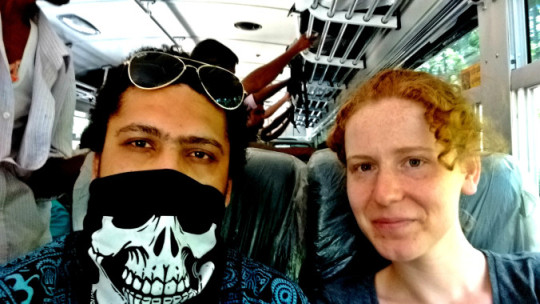
What lovely people we meet when we wander! During my commute to Dambulla. I met Julia, she was from Germany and was also travelling solo. Sitting by her made my journey more compelling as we talked all our way. We shared our experiences about the little big island. She has been travelling solo for some time now, covering a good number of countries. I told her that I would love to be her host cum guide when she comes to India.

Nice and beautiful people kept coming 🙂
To reach Sigiriya Rock, we’ve to change the bus from Dambulla and get on the one heading towards Pidurangala. The bus dropped me at this deserted place with a sign board stating Pidurangala leading to the woods. I followed my instincts and started walking towards the forest.
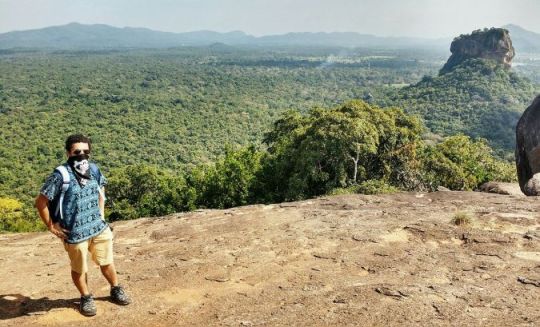
After walking for almost a kilometre I saw the Pidurangala Temple. Prayed to the Lord and starting walking the incline. The hike is brief but exhausting, however, once you reach the summit, the view is captivating. I could also see the Sigiriya Rock and I now wanted to visit the rock. Initially reluctant to visit it as the entry to it was 30$.
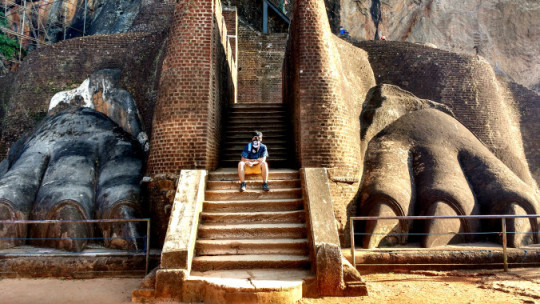
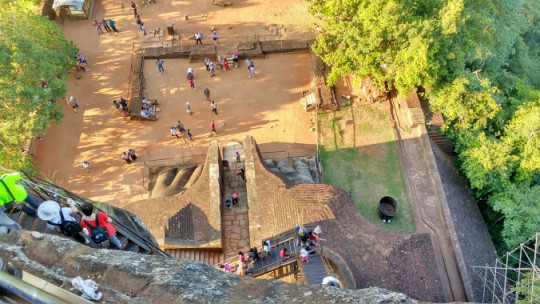
After reaching the Sigiriya Rock, I realised that it’s not a rock but a fort in the shape of a lion, whose head has dropped off somewhere. This massive piece of architecture makes you spellbound. One has to climb some 300 stairs to reach the top and again the view of the surrounding is astounding.
Now, I had to run to the Dambulla caves. Hence, I walked to the near Bus Stand. There was a bus there for Dambulla but no driver and passengers. Upon checking with some people around, I got to know that this bus was not going in my direction. I wanted to reach my destination before it gets dark, so I raised my thumb at a car coming to my direction. Thankfully, it stopped and offered me a ride till Dambulla. It was around 6 PM and I wanted to reach the cave temple as soon as possible as the entry closes after 6.30PM.
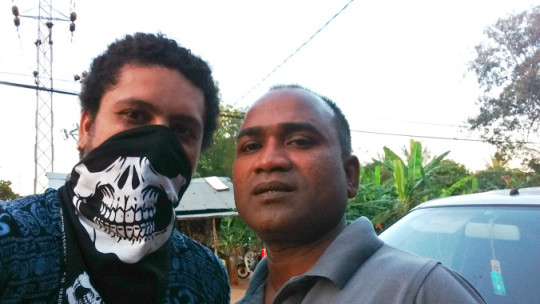
God Bless this gentleman for offering me a ride!
After getting off the car, I boarded a bus to the Dambulla Cave Temple but I was late. It was already 6.30PM. Still, I ran towards the entrance considering that I would somehow slip-in but the authorities did not let me. I desperately wanted to get in, so I offered the authorities a donation, to which they agreed and they let me in.
Delighted was I to go around the temple with these little monks, who excitedly showed me the entire place. It was astounding to roam inside these caves at this hour.
I came out of the temple and walked towards the Bus Stand near the temple. Lucky was I, the bus to Kandy just arrived. I got a seat.
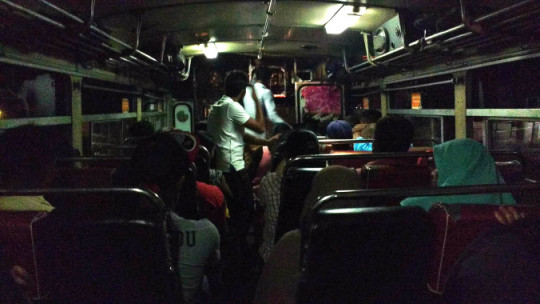
After 2 hours spending in the bus, I finally reached Kandy. And, slept like a baby as I was dead tired from all the walking I had done.
Day 3 Expenses – 6982LRK (46$) (a) Bus to Dambulla – 94LRK (b) Connecting Bus from Dambulla to Sigiriya – 60LRK (c) Entry to Pidurangala – 300LRK (d) Entry to Sigiriya – 1250LRK (e) Bus to Dambulla Cave Temple – 10LRK (f) Entry Donation at Dambulla – 1500LRK (g) Bus to Kandy – 98LRK (h) Dinner – 180LRK (i) Accommodation – 1745LRK
Note: Entry to Sigiriya Rock is for 30$, however, if your country is a member of SAARC (South Asian Association for Regional Cooperation) and you are carrying your passport then you are eligible for a 50% discount i.e. 15$.
Day 4 (Kandy – Nuwara Eliya)
I was suggested by a fellow traveller Logesh to visit Nuwara Eliya. So, I decided to change my plan, instead of going north I changed my direction to south. But before I could start my travel to Nuwara Eliya. I had to visit one more place in Kandy – The famous ‘Temple Of The Tooth’. I had a lot to do today. Thus, I woke up early had a heavy breakfast as always and headed towards the temple. I was told that the entry fee to the temple was 1500LRK for the foreign nationals. Thinking of the amount, I thought I would stroll around the place and will not enter the temple.
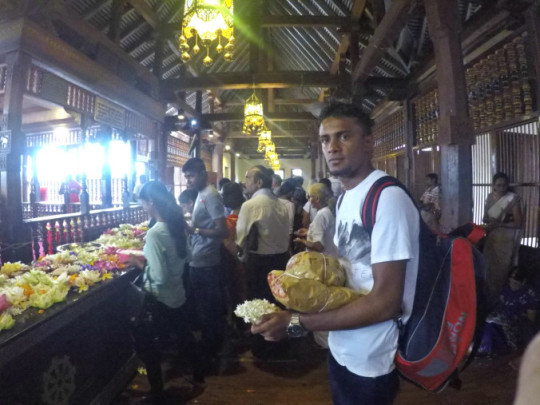
Asankya carrying the offerings
Fortunate was I that I bumped into Asankya. I local from Galle. After a chit chat about where I was from and where I am heading to. He told me that he can get me into the temple without paying a penny. It sounded like a plan and my mind I was happy that the amount that I paid as a donation at Dambulla Cave Temple would get compensated.
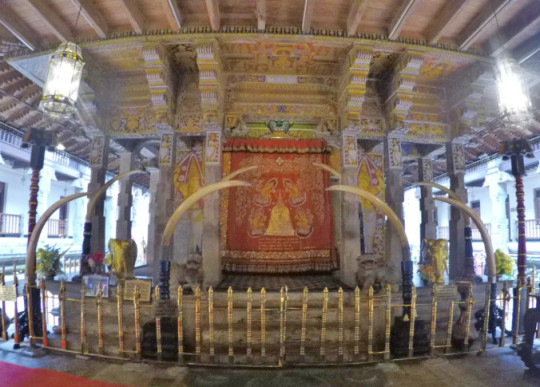
He asked me to stay mum till we pass the entry gates. And I did. Once I was in the temple a feeling of advantage came over me. I was happy.
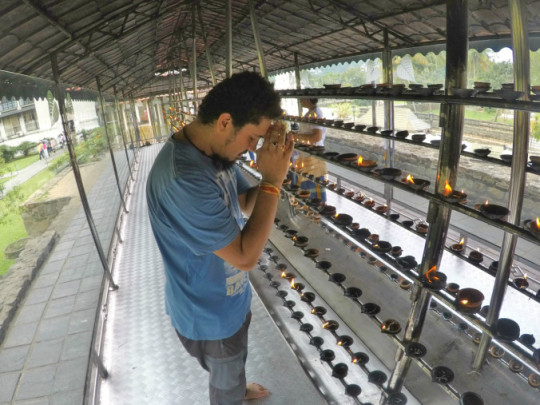
We offered the gifts to the Lord. Then, Ashankya showed me around the temple and the museum. I was grateful to him. He told me that he would try to meet me again at Galle when I go south and parted our paths. I returned to the hotel to pick my stuff. It was around 10.45 AM and the train to Nuwara Eliya was about to leave in the next 10 minutes. I was sure I would miss it and wait for the next.
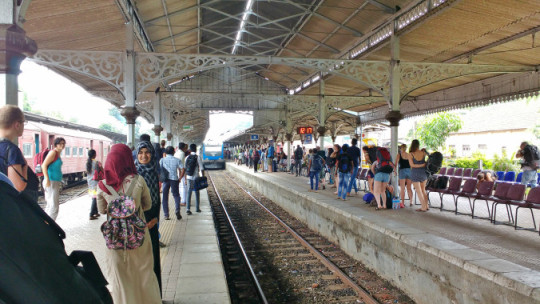
Luck was on my side today. The train was running late and it arrived at around 12 PM, a few minutes later after I reached the railway station. I got the window seat and couldn’t be more thankful as I got to know that this route was the most beautiful one in the entire country.
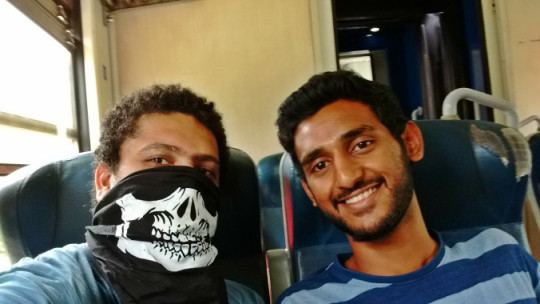
Hakeem and I sharing the lens!
Next to me was this gentleman named ‘Hakeem‘. Once, he got to know that I was from India, he started narrating his experiences of his travel to India. I was good to hear good things about my country. I saw the ticket checker approaching so I put my hand into my pocket to get the ticket. I realised it was not there. Probably, I had dropped it somewhere. I ran to the ticket checker and told him that I’ve lost the ticket. He calmly responded suggesting me to buy one from the next station. Hakeem helped me get the ticket from the next station. Also, when he dropped off at his destination; he got me some snacks too so that I don’t have to get down at any station if I was hungry. I had no clue how to thank him. Before I could say anything he was gone.
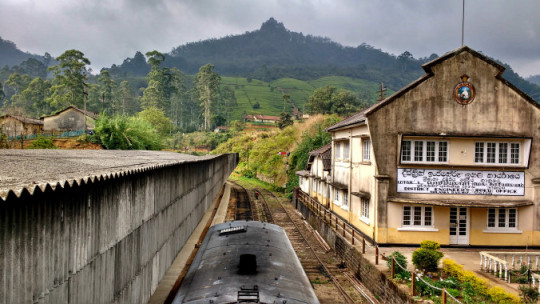
Beautiful Nanu Oya Railway Station
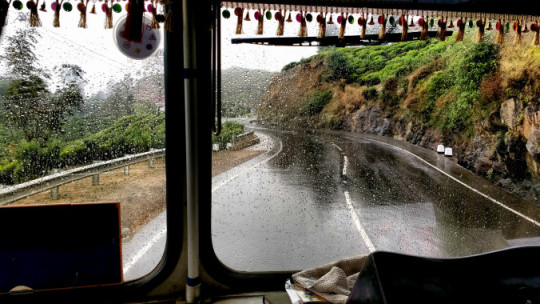
Reached the beautiful town of Nanu Oya but this was not my destination. So, I boarded a bus to Nuwara Eliya. I liked the weather, it was raining and it was cooler here as compared to Kandy. After reaching the Nuwara Eliya bus station. I used Google Maps to locate the hostel I had booked online. Maps showed me that it was 10 minutes walk from the station. I started walking, making my way through the woods.
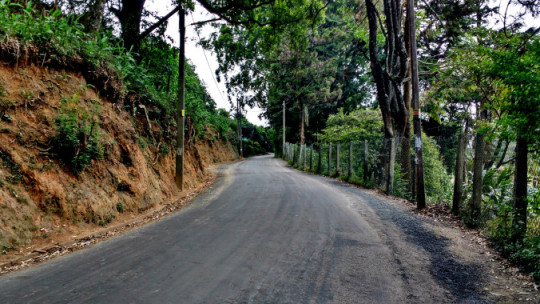
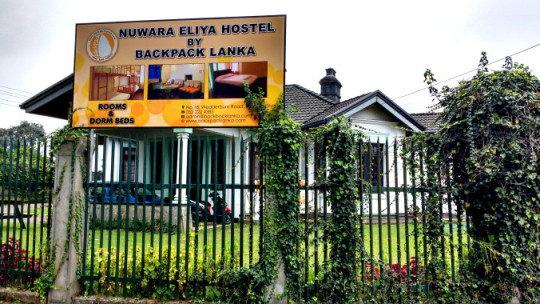
I booked a dorm bed at the hostel for 2 nights believing I would be able to cover as much as I could. It was around 5 PM and I wanted to see a couple of places before it gets dark. I decided to visit the ‘Ashok Vatika’; today’s ‘Seetha Amman Temple’ as everyone back in India had suggested me to visit the place.
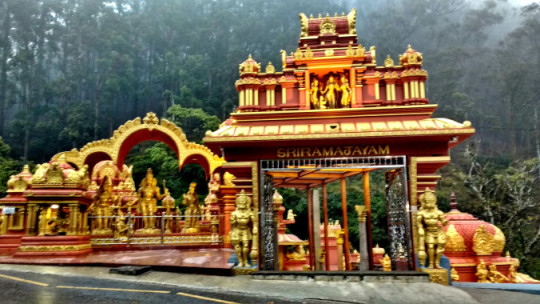
There was no one in the temple. I was the only person at this hour. From my childhood, we’ve heard stories about Ravana’s Lanka and places associated with Ramayana like any other Indian. I sat near the Feet imprint of Lord Hanuman for a while. The place made me feel a deep connection and I got hysterical.
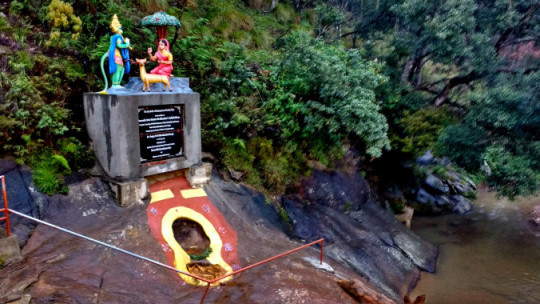
I wanted to stay longer but due to the brevity of time. I had to leave. The bus stand is opposite to the temple.
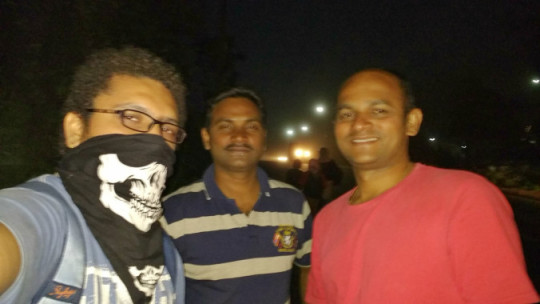
While I was waiting for the bus, I met these two gentlemen from India. We talked about the food, the people, the places. They were kind enough to give me company till I boarded the bus. I reached Nuwara Eliya bus station around 8 PM, went to this restaurant on the opposite side. I ordered Masala Dosai and a glass of milk. Once done, I walked back to the hostel. In less than 15 minutes I was in the hostel; good that I was carrying a flashlight because the path to the hostel turned dark.
Day 4 Expenses – 2060LRK (13.50$) (a) Snacks – 130LRK (b) Train Fare Kandy to Nanu-Oya – 160LRK + 150LRK (for the new ticket) = 310LRK (c) Hostel/ Dorm Charges – 1330LRK (d) Bus to Nuwara from Nanu-Oya – 25LRK (e) Bus to Hakgala (Seetha Amman Temple) – 30LRK (f) Bus to Nuwara Eliya from Seetha Amman Temple – 30LRK (g) Dinner – 205LRK
Day 5 (Nuwara Eliya)
I got up around 6 AM. Freshened up, had breakfast and left for Lover’s Leap Waterfall. I was told by the caretaker that the waterfall was just 3 Kms walk from the hostel. Within half an hour I was at this beautiful waterfall. I immensely enjoyed the walk as it provided me with a beautiful view of the town. You get to see trails of beautiful flowers along the route accompanying you.
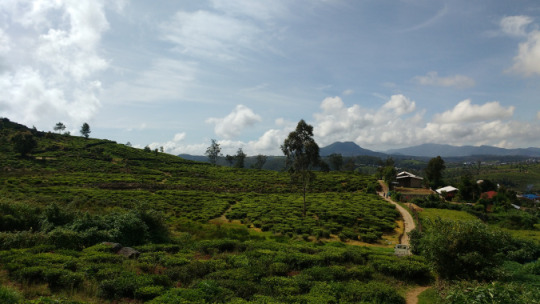
There was no one here at this hour of the day. So, I sat near the waterfall listening to the harmonica of the water splashing on the rocks. I was a marvellous feeling – Mother Nature and her child.
Realising that there were other places too that I had to see. I scuttled down the slant and luckily met Mr Nazim Zubin who offered me a ride to the bus station. It did save some time.
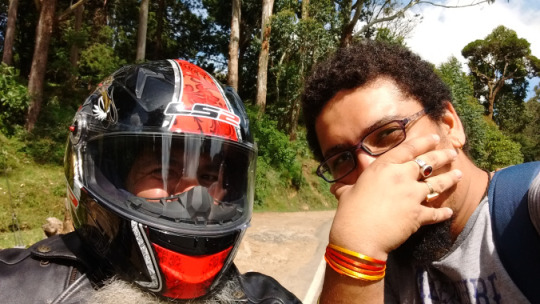
I took bus No. 311/1 which dropped me off a location leading to the Single Tree Hill. It’s a 2 Kilometre hike and every bit of it worth it. Firstly, You tend to see the whole town from another level of elevation. Secondly, you get to meet the locals collecting tea leaves from the tea garden. Also, there is a beautiful stupa on the way up.
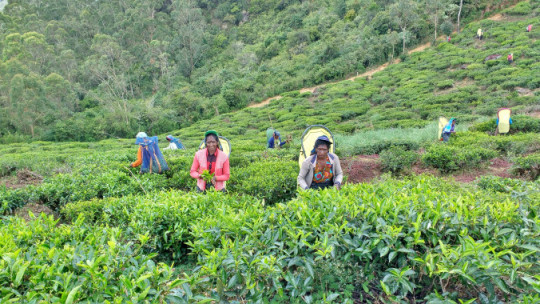
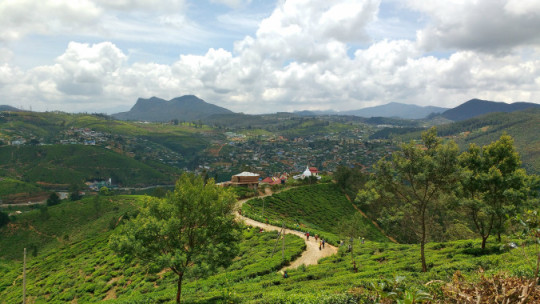
After reaching the summit I realised that there was no tree named ‘The Silent Tree’ instead the hill that I had just climbed was called the ‘Silent Tree’. I was not disappointed I sat there for a while and let the cool breeze lower down my body temperature.
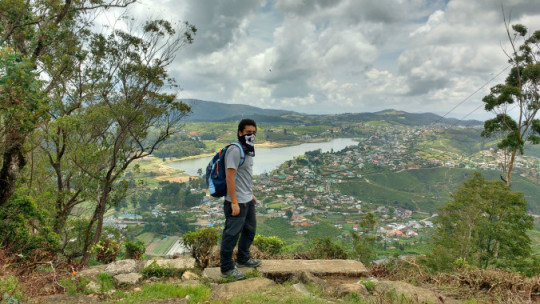
After climbing down the hill. I boarded a bus heading towards the Ramboda Falls. Within 30 minutes or so I was at the Ramboda Waterfall. People were clicking pictures and leaving the spot. But I observed a narrow path leading to the up the source. So, I climbed all the way up and found the real fall. Water was falling from a height of 390 meters and the view was mesmerising.
The view was so compelling that it urged me to take a dip under the waterfall. But there was a problem, there was no defined path to reach the fall. Anyhow, I removed my shoes, tied them to my bag and made my way through. I did stumble in between due to the presence of algae on the rocks but somehow I reached the point of bliss. I removed my clothes and jumped into the pool, feeling the love of nature. Once done, I came back to the highway from where I started the climb for the Ramboda Waterfall and asked a local for the direction to the ‘Hanuman Temple’. He said that I need to walk 2 Kilometres straight and I would reach my destination. And so I started walking….
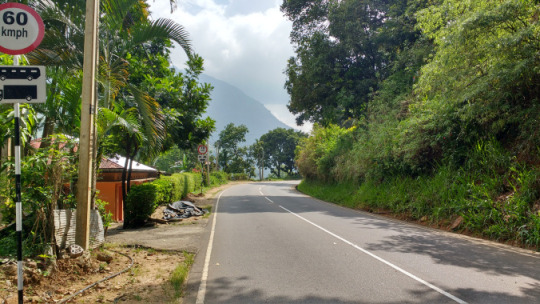
This walk was not exactly 2 Kilometres. It was far beyond that. Initially, I did not realise that but now it did not matter to me because the charm it offered me was priceless.
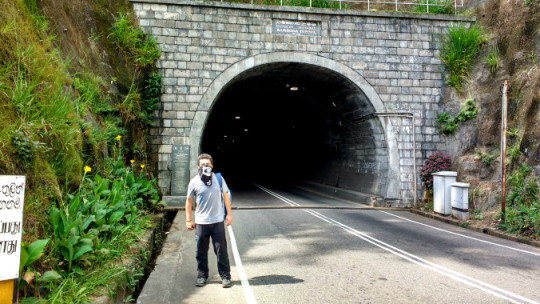
I walked through tunnels, saw beautiful waterfalls, lush green pine trees. The pure air filled my chest and I walked along the artistic road.
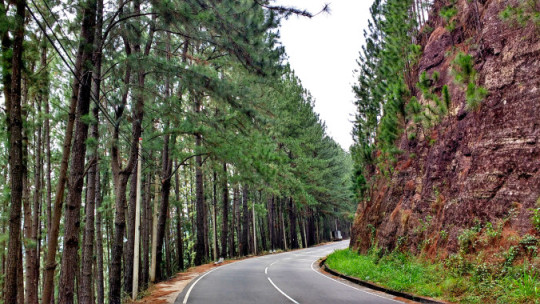
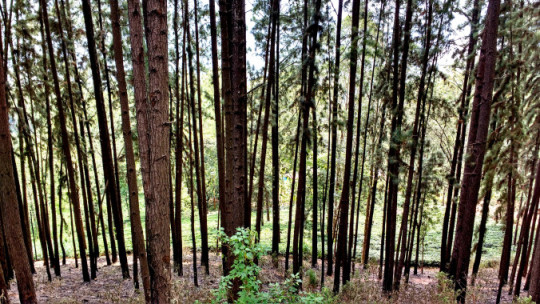
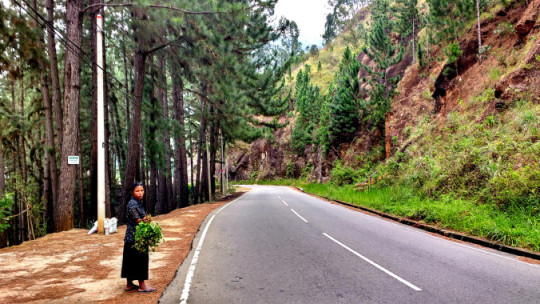
There were no cars on the road. Just a few locals selling vegetables and fruits besides the highway. They smiled when I walk passed them.
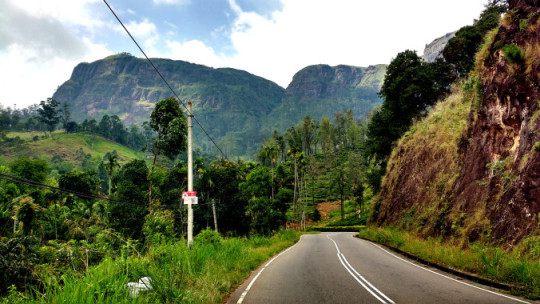
I walked for good 5-7 Kilometres until I reached a small restaurant. I was starving, so I asked the waiter to get me 2 glasses of Avocado Shake and noodles. After regaining my strength, I asked the restaurant owner how far the ‘Hanuman Temple’ was. He replied ��it’s just 2 Kms from the restaurant” but he suggested that I take a bus, which I did. It took 5 minutes for the bus to drop me near the temple.
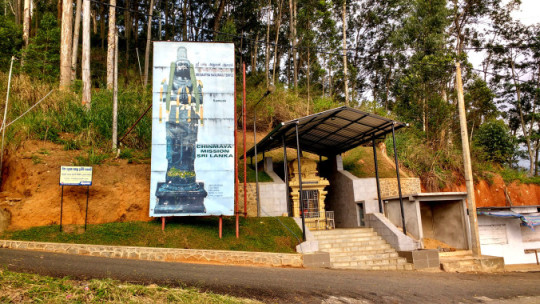
I bought offerings for the prayers from a shop near the entrance of the temple. And walked the 500 meters incline towards the temple.
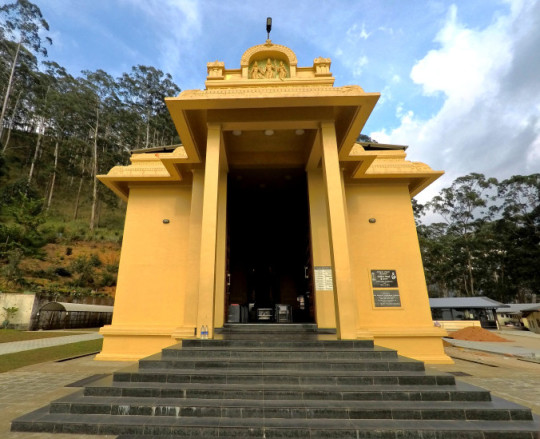
It was at the entrance of this beautiful temple. Photography was prohibited inside the temple so I was unable to click more pictures. I was taken aback when I was told that I had to pay for the prayers. This was unusual, anyhow I did pray the priest.
This was my final destination for the day. It was getting dark so I decided to return back to the hostel. I boarded the Bus heading to Nuwara Eliya and reached the hostel around 7 PM. While I was lying on my bed, these two guys (a Chinese and a Korean) come to my room and asked me if I wanted to join them for dinner. I accepted their invite and we headed to a local restaurant. The Sri Lankan food we’d ordered was pathetic, we told the owner of the restaurant that the food was bad and left the place. Then, we headed to this Chinese restaurant where we were well fed.
Day 5 Expenses – 2252LRK (15$) (a) Bus to Silent Hill – 20LRK (b) Bus to Ramboda Waterfall – 50LRK (c) Lunch – 300LRK (d) Offerings for the temple – 100LRK (e) Prayers – 20LRK (f) Bus to Nuwara Eliya – 52LRK (g) Dinner – 380LRK (h) Hostel Charge – 1330LRK
Day 6 (Horton Plains National Park – Maskeliya – Ella)
I was suggested to leave early morning for Horton Plains and The World’s End as it gets really hot during the day. Therefore, I got up around 4.30AM and left in an hour. I pooled up for the taxi and entry to the park with 3 other travellers in the hostel – 2 Chinese girls and an English man.
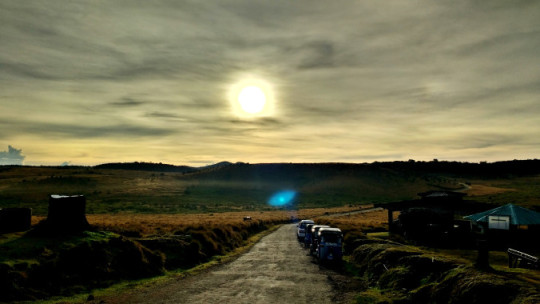
We stopped at a small eating joint before entering the park for a quick bite. After entering the park, we realised that it was crowded though we reached the place quite early.
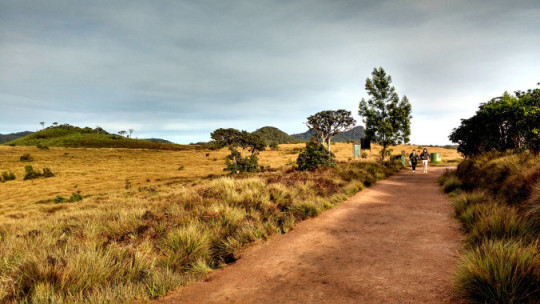
We started walking towards the Mini World’s End initially and reached the location in good 30 minutes or so. Others got to see the Sri Lankan Sambar, some wild birds, and monkeys but I was not that fortunate. However, I enjoyed the walk though.
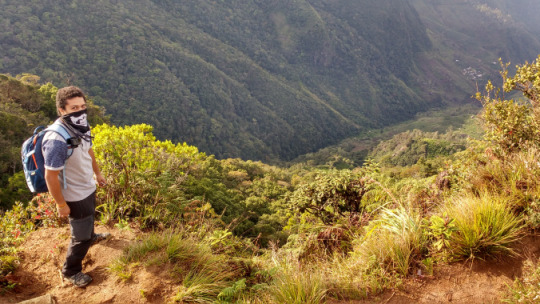
Mark and I walked along the narrow path sharing our travel experiences, of people, places, and food. He had been travelling from the south of Sri Lanka towards the north and I was doing the opposite.
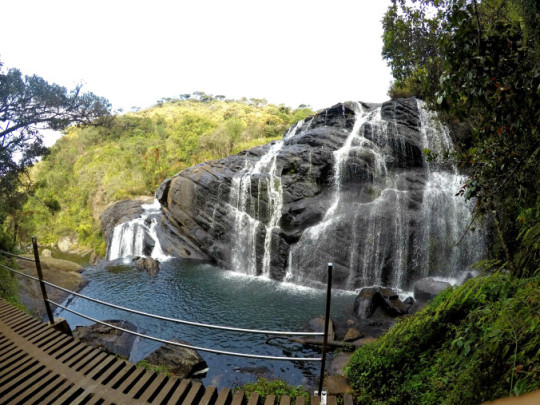
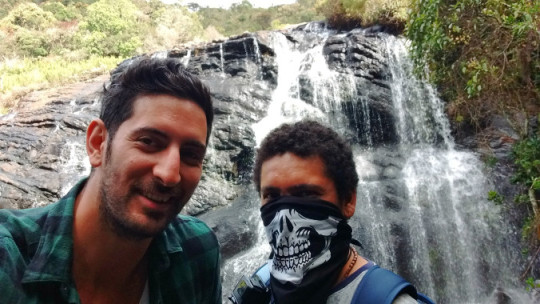
Mark helped me get some great pictures of the Mini World’s End, the World’s End and the Baker’s Fall. It feels marvellous to meet nice people and sharing cultural differences.
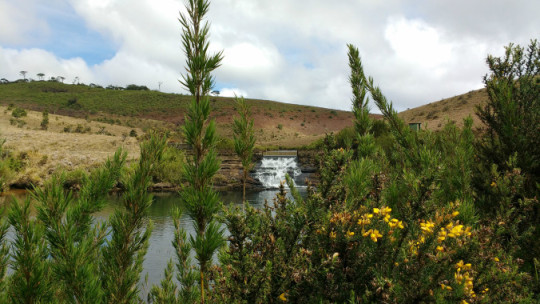
After returning from the Hortons Plain. I started packing to move to my next destination – Adam’s Peak. Initially, I was not planning to visit climb the Adam’s Peak but after learning from Mark and Julia about it I added it to my itinerary.
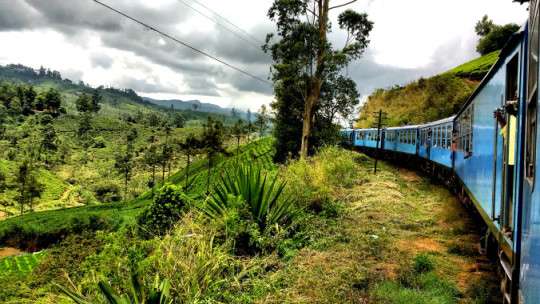
I took a bus from Nuwara Eliya to Nanu-Oya Railway Station. I was about to miss my train to Hatton but I ran like a horse towards the ticket counter, got a ticket and hopped on the train.
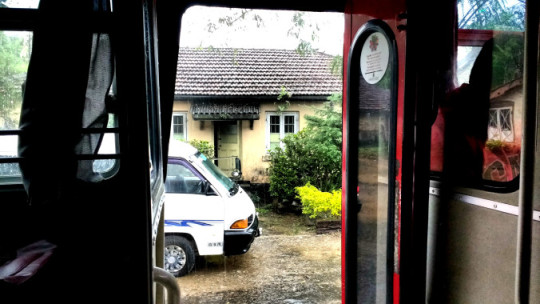
I reached Hatton around 1.30PM and it was pouring. But I was fortunate that a bus was waiting just outside the Railway Station. It was heading to Dalhousie. During my commute, I was searching for an accommodation in Dalhousie but all options were out of my budget.
I dropped off at Maskeliya for a cheaper accommodation. I found a place to spend the night but it was really far from the bus station and a good 5 Kms from the Adam’s Peak. Anyhow, I walked towards the “Madhusa Rest” house. Somewhere in between, I felt that I was lost but there some these school kids who helped me find the place.


I told the caretaker not to disturb me until the dinner was ready because I really wanted to rest before the excruciating hike. The caretaker also arranged a tuk-tuk for me who would take me to Adam’s Peak at midnight.
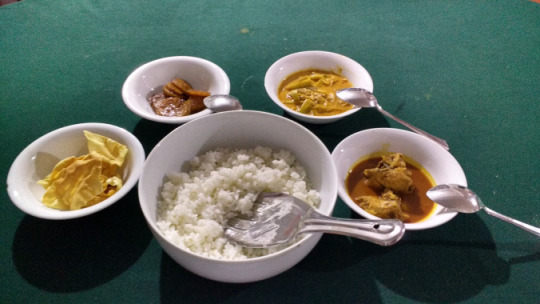
I had a typical Sri Lankan dinner. It looked great but I was not accustomed to the taste, so I left in between and slept. Around 1 AM I heard the sound of a tuk-tuk arriving, I freshened up and left to the climb.
Day 6 Expenses – 7004LRK (46$) (a) Taxi to Horton Plains – 1250LRK (b) Breakfast – 190LRK (c) Horton Plains Entrance Fee – 2900LRK (d) Bus to Nanu-Oya – 24LRK (e) Train to Hatton – 60LRK (f) Bus to Maskeliya – 70LRK (g) Snacks – 120LRK (h) Accomocdation and Dinner – 2390LRK
Day 7 (Adam’s Peak – Maskeliya – Ella)
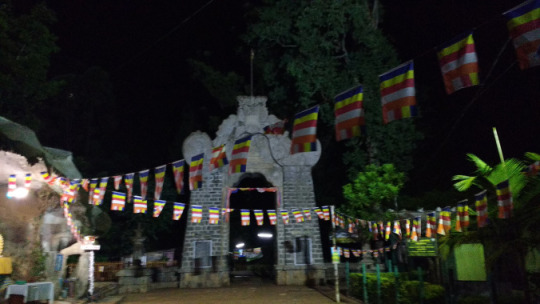

I underestimated the climb. But soon realised that it would get tough as I go further. I wanted to grab a perfect point to view the sunrise from the summit so I walked as fast as I could without stopping anywhere in between.
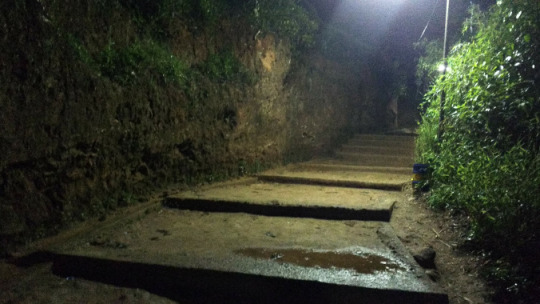
Somewhere I between I looked at the sky. It looked beautiful, it seemed as if the stars looked at me guiding me through the deserted path. I wanted to stop and stare at the sky but due to the brevity of time, I kept walking.
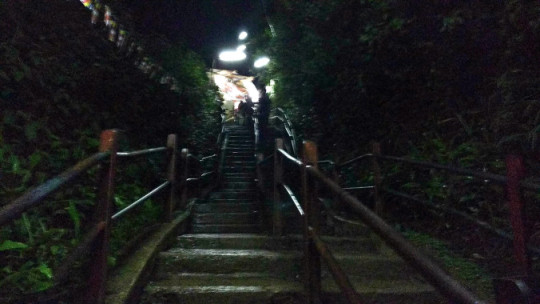
By 4.30 AM I was at the summit. The hike was gruesome and it tested my endurance and agility at all levels. But every bit of it was worth it. I took a seat at a seating area near the temple and meditated till dawn.
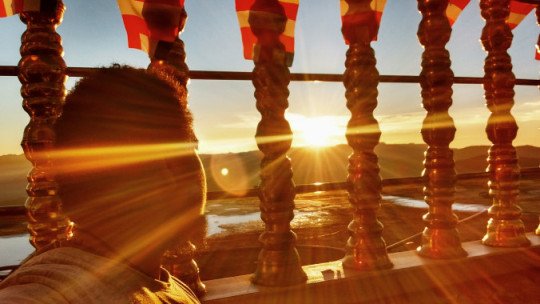
The sunrise was too majestic to describe. I looked it until I had completely grasped the beauty of the moment. I roamed around the temple for few minutes and then started running down the stairs. I took 45 minutes to come down.
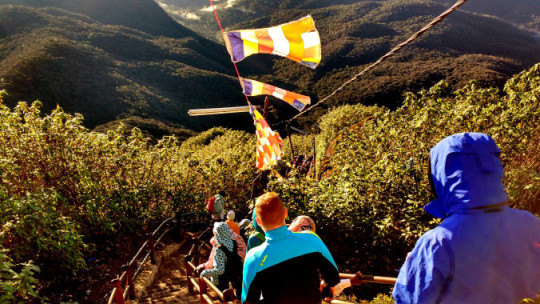
I took a bus from the Adam’s Peak bus station to Maskeliya. Within 20 minutes I was at the guest house. I took a shower, packed my stuff and headed towards the Bus Station to take a bus to Hatton.
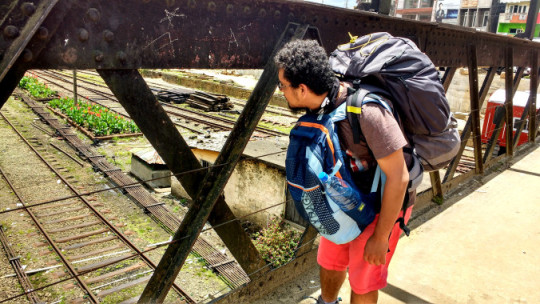
Though I left early for Hatton, I missed the 11.30 AM train. So, I headed for lunch and returned to the railway station around at 1.45 PM to catch the 2 PM train.

During my commute to Ella, I met Vicky from China. We talked about the countries we’ve travelled. Shared our experiences. She wanted to know more about India like why certain people wear turbans and why the married women wear vermilion on their forehead. I explained her as much as I could and it was fun to talk. Around 6 PM, we reached Ella and bid farewell to each other.
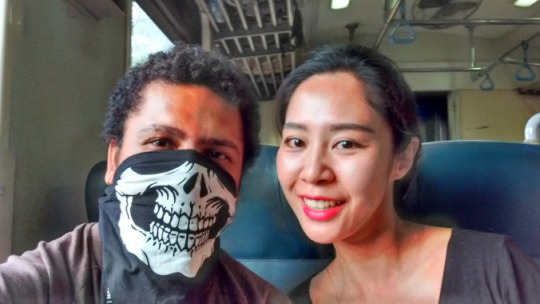
I had booked a bed at the ‘Sleep Cheap – Ella‘ guesthouse, which was not far from the railway station. While I was walking towards the hostel it started to rain and I had to take out my poncho and hurried.
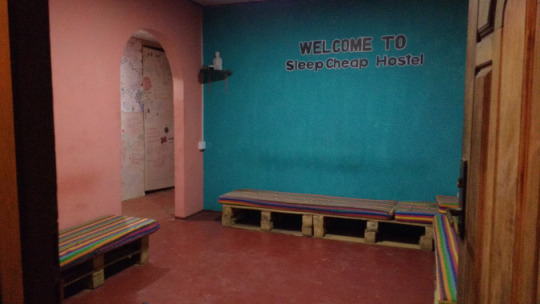
Once, it stopped raining I left for the Ella market. During the evening hours, Ella seems to become a different place altogether. You see people walking, hear music from the pubs and happy hour boards placed outside all bars. Without any delay, I stepped into a restaurant and offered ginger beer and pineapple roti. Once done, I went back to the hostel.
Day 7 Expenses – 3070 (20$) (a) Tuk-Tuk from Madusa Guest House to Adam’s Peak – 700LRK (b) Bus from Adam’s Peak to Maskeliya – 40LRK (c) Bus to Maskeliya to Hatton – 45LRK (d) Snacks – 110LRK (e) Lunch – 200LRK (f) Train to Ella – 160LRK (g) Dinner – 320LRK (h) Accommodation – 1500LRK
Day 8 (Ella – Little Adam’s Peak – Ravana Falls – Ella Rock)
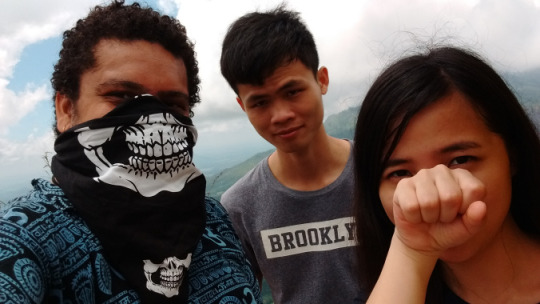
Next morning during breakfast, I met Quan and Aines from China. They were in Sri Lanka for a week. I was planning to climb the little Adam’s Peak, so were they. So, they tagged along with me.



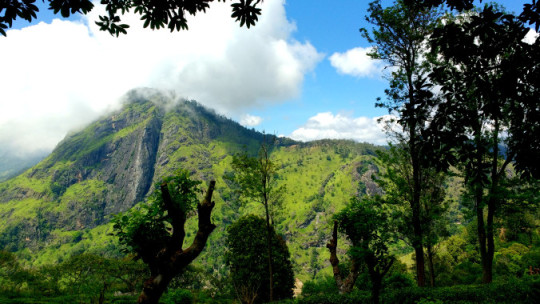
We walked through this path exhibiting us the beautiful landscapes, talking about the similarities of China & India. Our education system, people, government, etc. The places we want to travel and not get married soon enough.
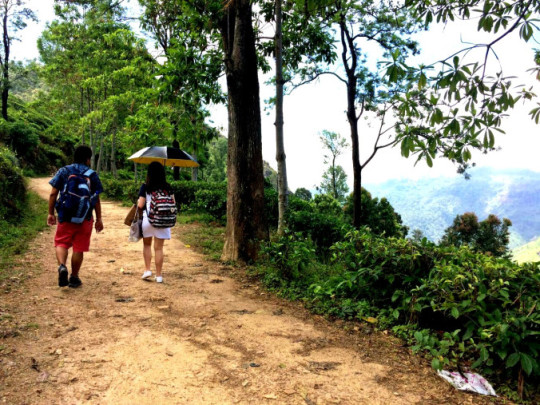
Aines shared her story, how laboriously her parents worked for her education. At one point, she really got emotional. At that instance, I realised for similar people are though we are from different worlds.
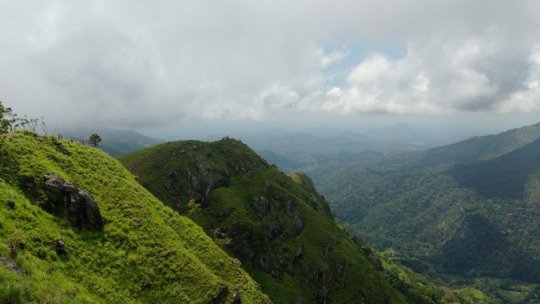
Aines and Quan had to catch a bus so they left. I bid farewell to them and I moved to the next peak. Little Adam’s Peak is an easy trek. So, it did not take us long to reach the peak. The view was amazing and in front, I could see Ella Rock, which I had to climb before the end of the day.
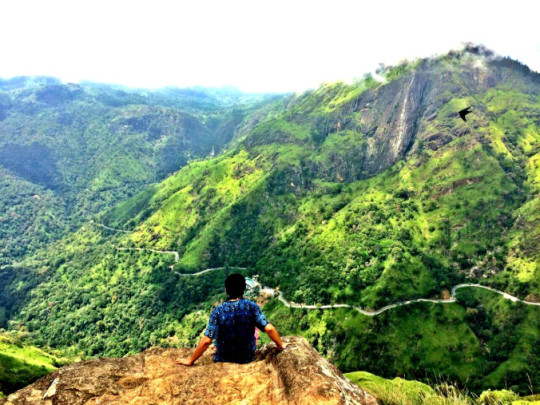
The view was majesticI so I clicked few pictures and sat there for a while. Then, I walked down the hill for the Ravana Waterfall.
Google Maps showed me Ravana falls at a distance of 6 Kms from my location. To save some time, I thought of hitchhiking. So, I raised my thumb high. I could see a motorcycle approaching, it stopped and offered me a ride.
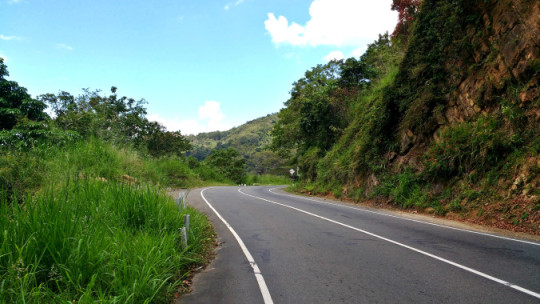
The rider’s name was Sumit and he came to know that I was from India. He told me how big a fan he was of the Indian Cricket Team. His favourites were Virat Kohli and MS Dhoni.
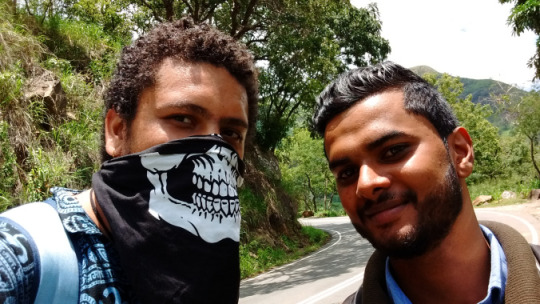
While we were lost in our conversation, we saw a police barricade ahead and I guessed it that we were in trouble. I was not wearing a helmet. The policeman on duty stopped us. He asked me to leave. I tried to give an explanation but I was waved-off. Even Sumit asked me to leave the spot. Feeling guilty, I left. I walked a few hundred meters and could see Sumit coming towards me. He stopped and said that the police gave him a verbal warning and let him go. The policeman was a nice man, he made him think of a scenario where a foreigner meets with an accident then what would consequences he would have to face. It was thoughtful for me too. Anyhow, Sumit did leave me till Ravana Falls.
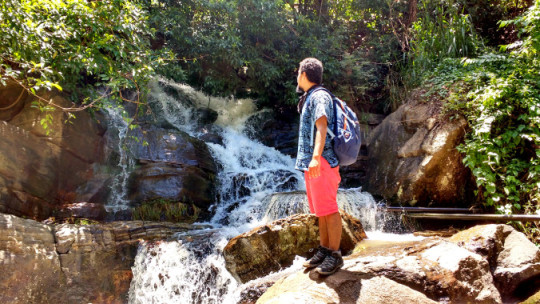
I didn’t find this place amusing. Just a waterfall by the road with few people getting pictures clicked.
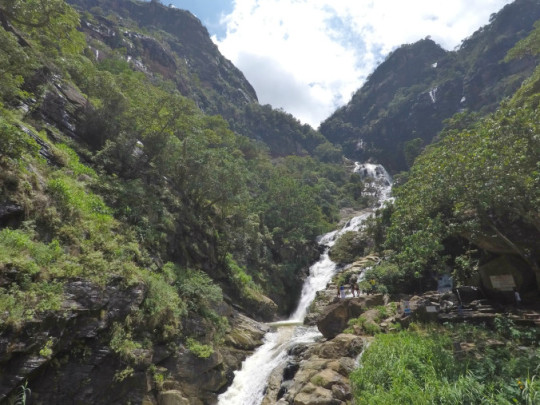
My last attraction to cover in Ella was the “Ella Rock”. Therefore, I boarded a bus to Ella and started walking towards the rock.
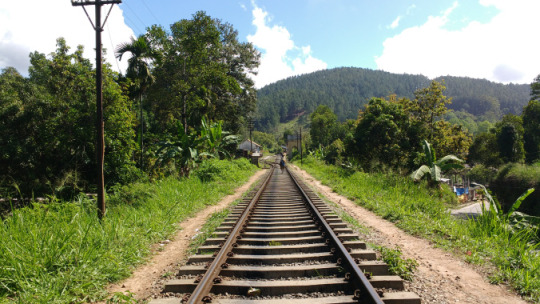
One has to walk along this railway track for good 2-2.5 Kilometres first. Then, there is narrow passage along the forest leading to the Ella Rock. During my walk along this wonderful foliage by the track, I met a lot of hikers returning and they guided me through.
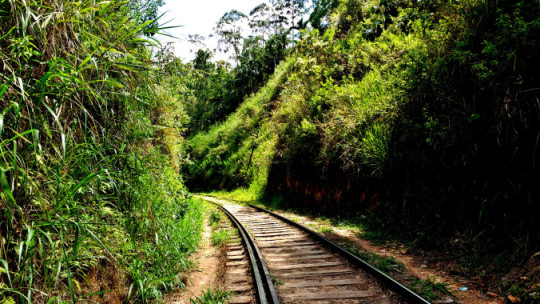
I was lost somewhere in the forest. But by God’s grace, I met Anil, a villager from Ella Village. He walked with me till I was back on the trail. I gave him 100LRK for helping me out.
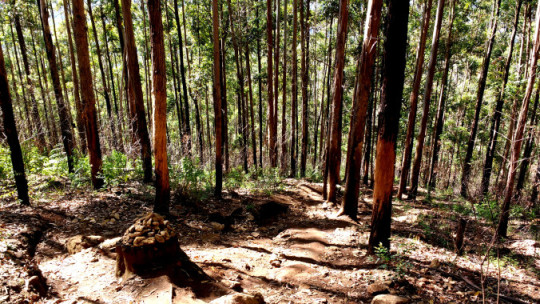
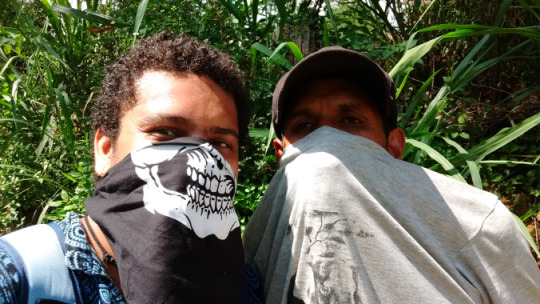
In total it took good 2 hours for me to reach the rock. I sat on the edge of the rock enduring the cool breeze. The view of from the rock was thrilling. One can see the Little Adam’s Peak in front, the petite village at the bottom and enormous ranges all around.
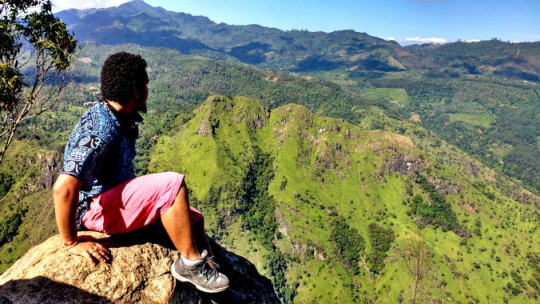
While I was grasping the beauty around. I saw Priyantha and Pradeep approaching. They were curious to know where I was from and what I was doing here all by myself. I told them all and it clicked well. We talked about all kind of stuff from Cricket to Buddhism to how we are missing good things in our lives of hectic work schedule.
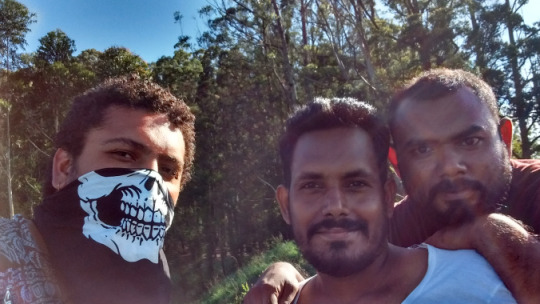
While I was returning back, I met Mark and Eleonora. I’ve been bumping into them for a while. First, I met them at the Nanu-Oya Railway station then the Little Adam’s Peak and now the Ella Rock.
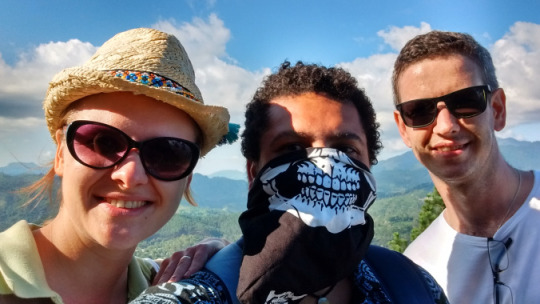

On my way back, I lost my path. Thankfully, my phone had enough juice to guide me though. I finally reached the hostel before dark. For me, the most memorable part was walking along the track.

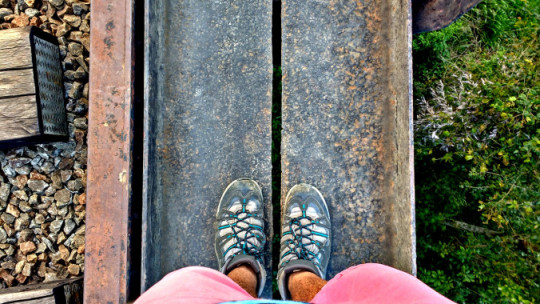
In the evening, the town turned hazy. Looking at that I went to this pub playing some great music and ended my day there.
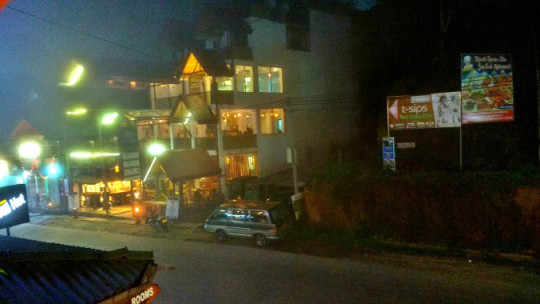

Suggestion: When visiting Ella Rock, keep track of the path and continue asking the locals for the route. Don’t take a guide, it’s not required.
Day 8 Expenses – 2825LRK (18.50$) (a) Accommodation – 1500LRK (b) Bus to Ella from Ravana Falls – 25LRK (c) To Anil – 100LRK (d) Dinner – 1200LRK
Day 9 (Ella – Mirissa)
After breakfast, I left for the Ella Bus stand to catch a Bus to Mirissa. But, there is no direct Bus. So, I boarded a bus to Matara. It’s a four-hour journey from Ella to Matara. And, Mirissa is 30 minutes distance from Matara. I reached Mirissa in the afternoon. It’s a beautiful town, with a lot of restaurant and shacks by the beach.
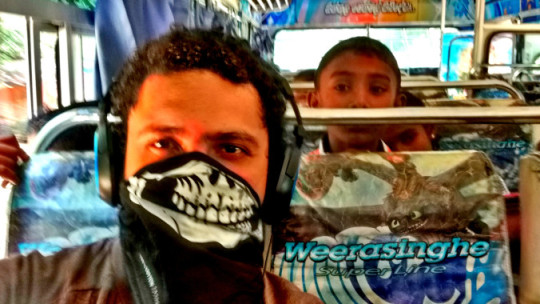
I stayed at the ‘Sun Vivanta Resort’ which was is and managed by a cute couple. I was offered a king coconut, freshly cut, from the tree to quench my thirst, when I arrived at the resort.
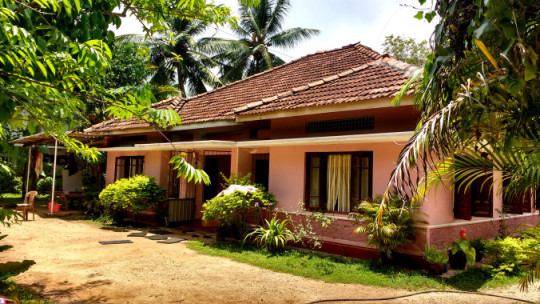
Though I had booked a single-bed room, they offered me a comfortable double-bed room. Laundry was not a part of the amenities offered but they allowed me to use their washing machine.
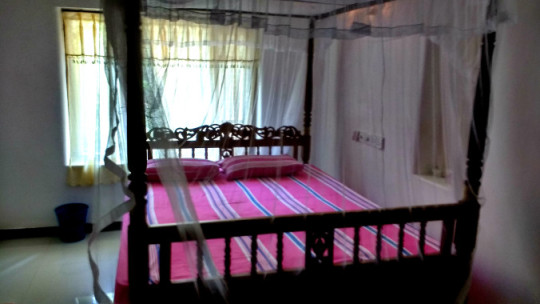
The owner suggested me to go for ‘Whale Watching’ the next morning. I agreed to it. He made all the arrangements. Later in the evening, I thought of taking a walk by the beach. And I met this lovely couple from Czech – Mark and Eleonora again. I sat with them for a while and told them that, there was kind of power that was making us meet every now and then. For dinner, I had cheese roti which had a stuffing of eggs, cheese and vegetables; it was delicious.
Day 9 Expenses – 2590LRK (17$) (a) Accommodation @ Sun Vivanta Resort – 1500LRK (b) Bus to Matara from Ella – 400LRK (c) Bus to Mirissa from Matara – 40LRK (d) Lunch – 250LRK (e) Dinner – 400LRK
Day 10 – Mirissa
Early morning around 5 AM, the owner of the resort, woke me up. He had arranged a tuk-tuk for my pickup from the resort to the harbour. I got ready and reached the place by 6.30 AM. We left for the ocean at 7 AM.
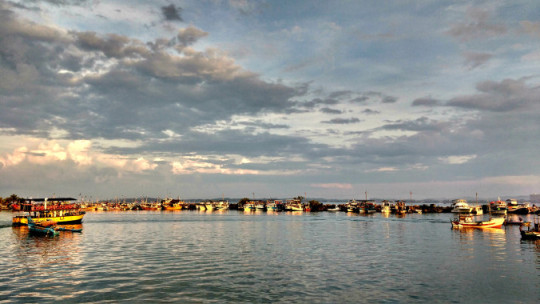
Exhilarated was I, as the boat sailed on the sea in a harmonic pattern. I felt a profound connection to my soul with the deep blue water of the ocean. It took good one hour or so to reach the spot where the big mammal is spotted.
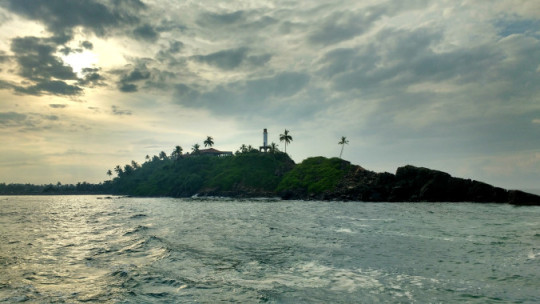
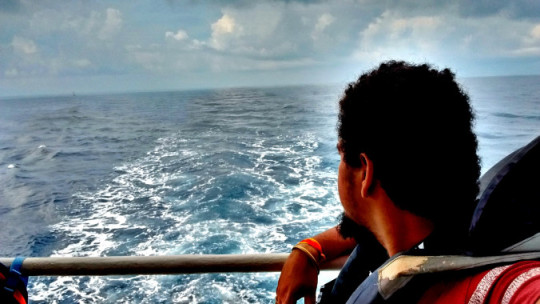
We had to wait for some time to see the big blue whale. Our boat stood still in the blue water, all of us waiting to see a glimpse of the creature. The captain said that the whale comes every 15-20 minutes to the surface. So, we were waiting patiently.
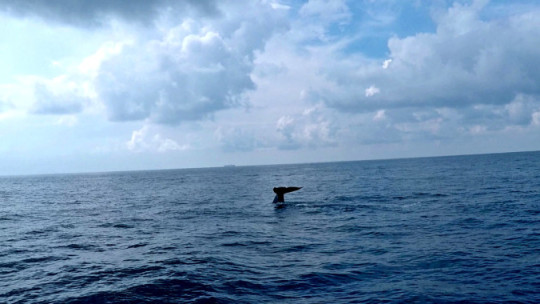
We did see a couple of whales. After which, we headed back to the port. I fell asleep and got up when we were about to reach the harbour. I was famished by then, I headed to this restaurant near the resort for lunch. As it got too hot during the day, I stayed at the resort and relaxed.
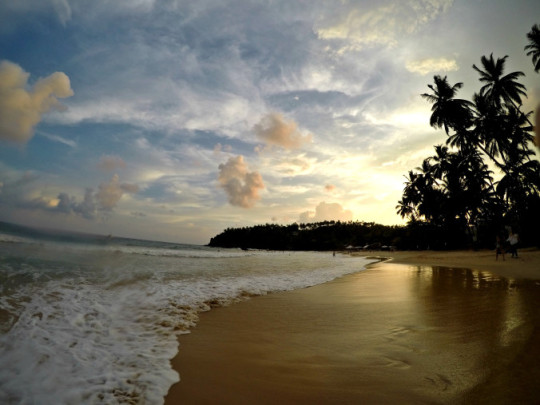
In the evening, I left for the beach. The blue water and the blue sky complemented each other. I got into the shallow water and while I was enjoying myself two mammoth size waves hit me. First, I tumbled into the water and as soon as I tried to get on my feet, the second wave pushed me to the ground. I felt an excruciating pain on my right knee. I sensed something bad has happened. Somehow, I came out of the water, changed and headed for the resort.
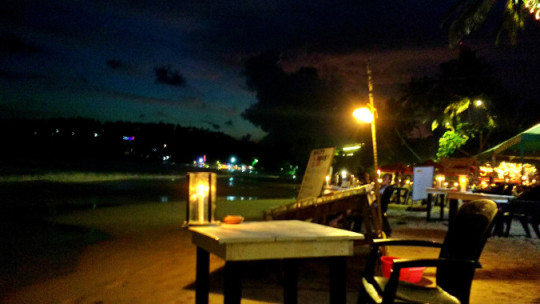
I knew deep down that I may not be able to continue my trip with an injured knee. So, I stopped that thought from getting into my head. Rather, I thought of enjoying the moment.
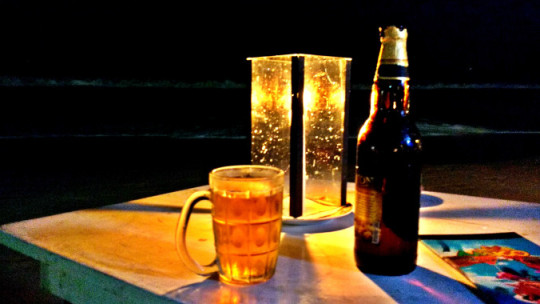
I went a little off my budget. I took a seat at a table by the beach and ordered few beers and barbequed chicken. There was no one around and even in pain, I was content.
Day 10 Expenses – 5510LRK (36$) (a) Accommodation @ Sun Vivanta Resort – 1500LRK (b) Whale Watching – 2000LRK (c) Lunch – 560LRK (d) Dinner – 1450LRK
Day 11 (Mirissa – Galle)
Next morning, I got up a bit late. I was unable to bend my knee, the pain had worsened. The owner of the resort gave me some kind of ointment but it didn’t provide any relief. I made my mind and thought of continuing my journey. I had breakfast which the owner’s wife had cooked, it was some authentic Sri Lankan food; it was exquisite.
I boarded a bus from Mirissa to Galle around 11 AM and reached Galle in an hour. It was getting really hard for me to travel. I met this English couple on the bus who gave my some painkillers by looking at my state. I wish I had clicked their picture but I was not in the right state.
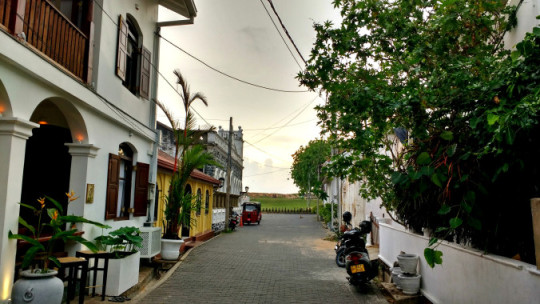
It took me good one hour to walk 1.5 Kilometres to reach my hostel from the bus station. It was painful and the day felt really hot. This became the most memorable day of my trip for me. I stayed at the ‘Pilgrims Hostel’. Thankfully, it was not far from the Galle Fort, Lighthouse and the beach.
I was exhausted from walking in this state and wanted to rest. Moreover, it was too hot and humid during the day. So, I took a nap during the day after having the pain killers.
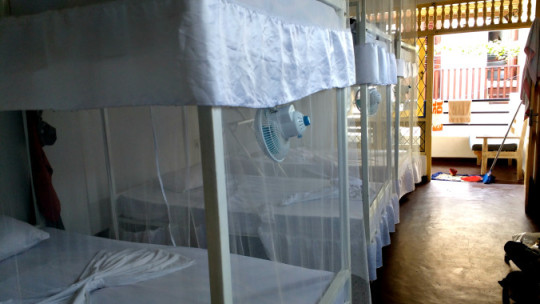
Around 3 PM, it rained and the weather got pleasant. I took a seat at the balcony and looked at the sky as it rained. By this time, my pain had reduced or I would say, I got accustomed to it. Once, it stopped raining, I thought of taking a stroll around the fort.
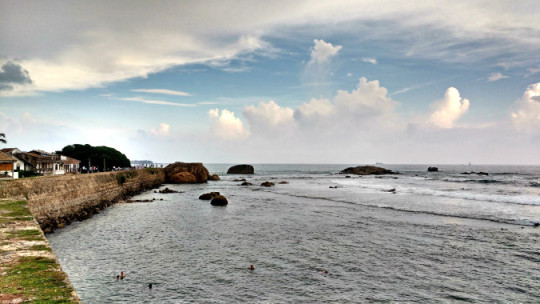
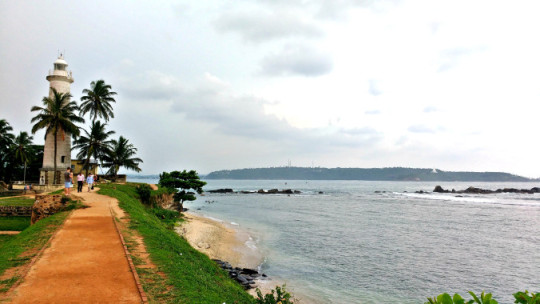
As I walked around the fort, I saw couples walk holding hands, school kids clicking pictures, pedlars selling toys and candies. People swimming at the beach, some girls collecting seashells. Everyone seemed gleeful. I took a seat at a corner and saw the sunset steadily.
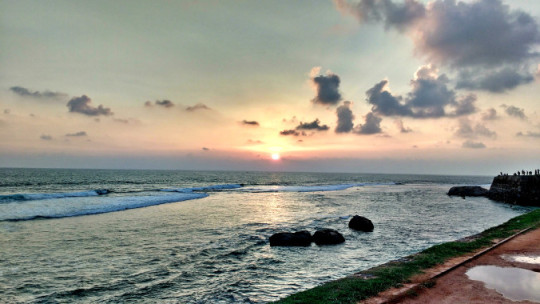
Day 11 Expenses – 2654LRK (18$) (a) Accommodation Pilgrims Hostel – 1800LRK (b) Bus from Mirissa to Galle – 54LRK (c) Dinner – 800LRK
Day 12 (Galle – Anuradhapura)
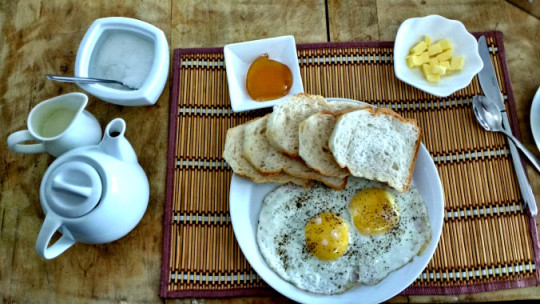
I left for Galle Railway Station after having an awesome breakfast. My knee continued to hurt. I was thankful to this doctor in the hostel who gave me few painkillers. It helped me for a while. I planned to travel the north before I leave. So, I purchased a ticket for Anuradhapura.
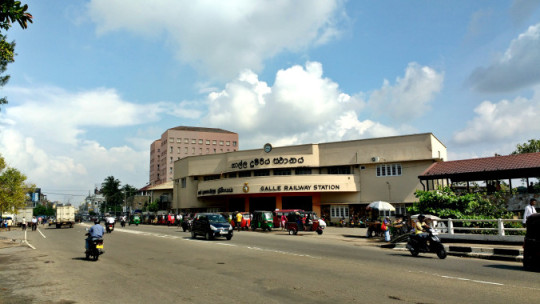
It was a long tiring journey. To add more to this torment, the train took multiple stops. Though the journey was tiring, it was not monotonous as I got the company of Joshua and Michael; they were from Canada.
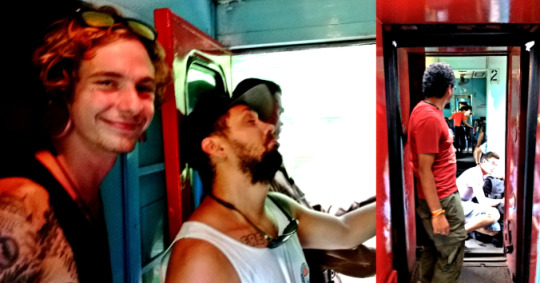
The train was crowded and we did not get seats. Thus, we stood by the door, talking all kind of stuff. They got off at Colombo and I got a window seat. I reached Anuradhapura at 7 PM. It got dark so I took a tuk-tuk to the hostel.

I stayed at this place called ‘Lion Rest’. An average place, with minimal amenities but it served the purpose. I went to a local restaurant, had noodles, returned and went off to bed.
Day 12 Expenses – 2490LRK (17$) (a) Accommodation Lion Rest – 1500LRK (b) Train to Anuradhapura – 310LRK (c) Snacks & Water – 200LRK (d) Tuk-Tuk from the Railway Station – 100LRK (e) Dinner – 380LRK
Day 13 (Anuradhapura)
My injury had made me weak and to some extent killed my enthusiasm. I woke up a bit late. I was running short of cash. So, I walked around few ATMs and finally found the right one. It was the Commerical Bank ATM that read international cards. Anuradhapura was different from all cities/towns I visited in Sri Lanka. Everything was pretty scattered here. So, I took a tuk-tuk and asked the driver to take me around the city.
First, I went to see the Sri Maha Bodhi tree. One has to remove their shoes/slippers before the entry. After which you have to walk into the temple from any of the four gates.
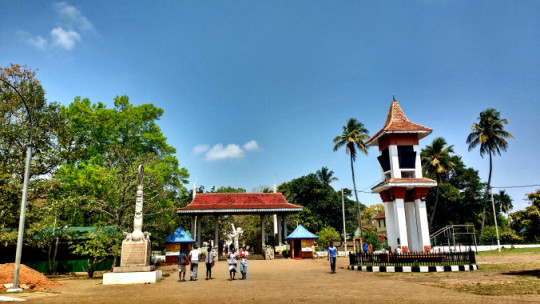
The Sri Maha Bodhi is said to the oldest and longest-surviving tree in the world. It was planted in 288 BC. It grew from a branch taken from the Bodhi tree in Bodh Gaya, India where Siddhartha Gautama attained enlightenment and became known as Buddha more than 2,500 years ago.
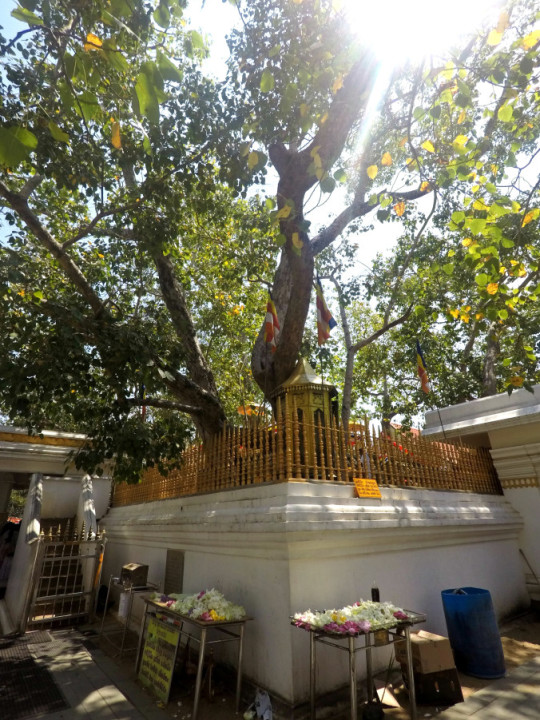
One gets to see a huge number of devotees coming to the place with offerings. Several of them tend to spend hours sittings by the tree and its whereabouts.
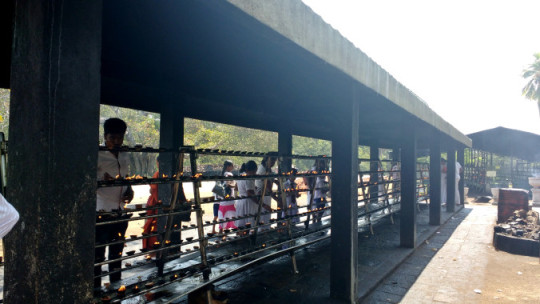
Suggestion: Carry a pair of socks, you would be requested to remove your shoes. The floor gets really hot and it’s very hard to walk barefoot.
After the Bodhi Tree, I asked the driver to take me to Mahiyangana Stupa, is believed to be the site of Gautama Buddha’s first visit to the country.
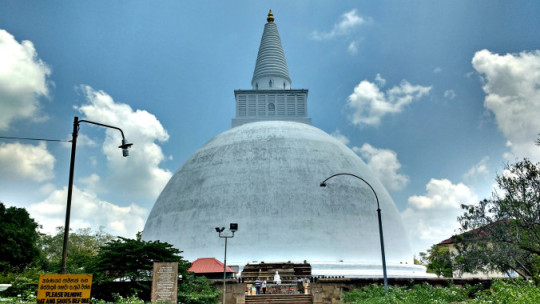
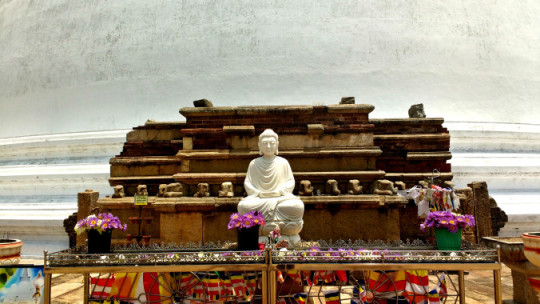
Then, I went to a temple which had some 500 statues of monks meditating with Lord Buddha. There was no one there as it was too hot at this hour of the day.
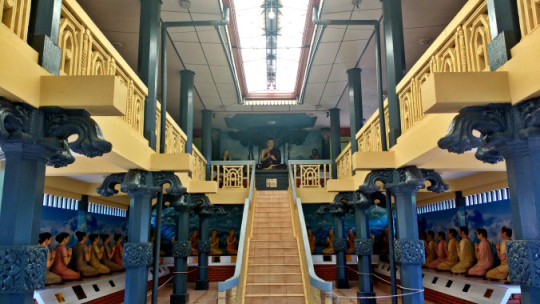
I roamed around the place. It was very peaceful. Even the tuk-tuk driver clicked pictures of the place. And we sat there for a while.
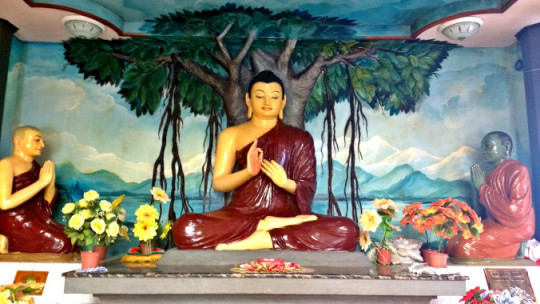
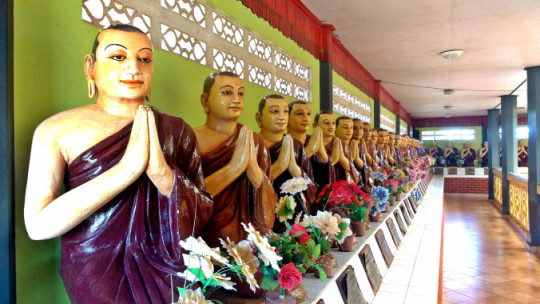
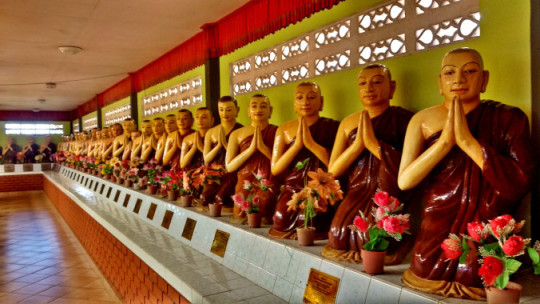
We then headed to the Isurumuniya Temple. There is an entry fee to it. It is one of the oldest Buddhist temples of Sri Lanka. I was not wearing socks which made it really tough for me to roam around.

I was hopping around the place with an injured knee. Also, it was extremely hot. But, I did tour the complete temple.
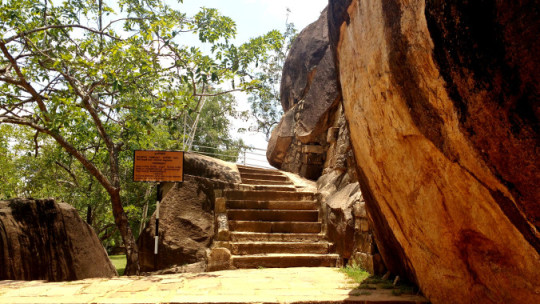
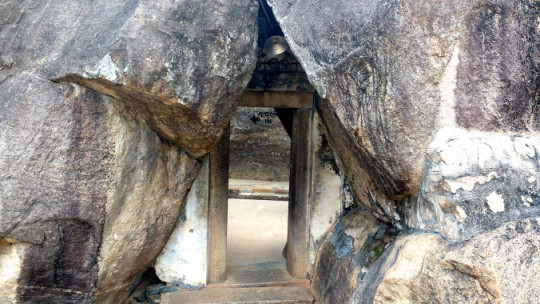
I also climbed to the top from where one can see the whole city. It took me good 10-15 minutes to reach the top but I loved it there. I stood there for a while till my body regained its strength.
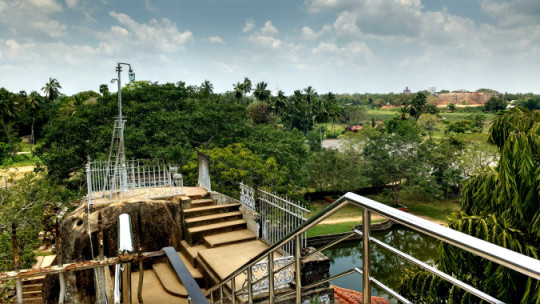
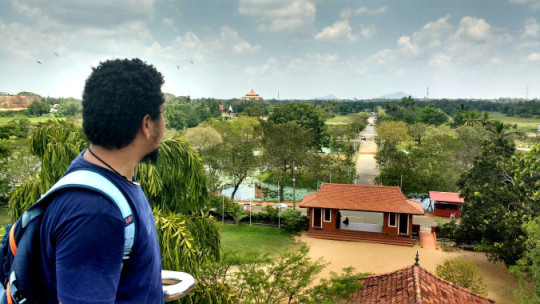
While I was getting down, there was a family climbing up. Looking at my agony, they asked me why I was limping. I narrated the whole incident. They asked if they can see my knee. I said yes. Later, I found that 3 people in that family were orthopaedics. What Luck! They checked my knee movement and the prescribed me some medicines. They believed that I had suffered a ligament tear. I thanked them and headed to my last destination of the day.
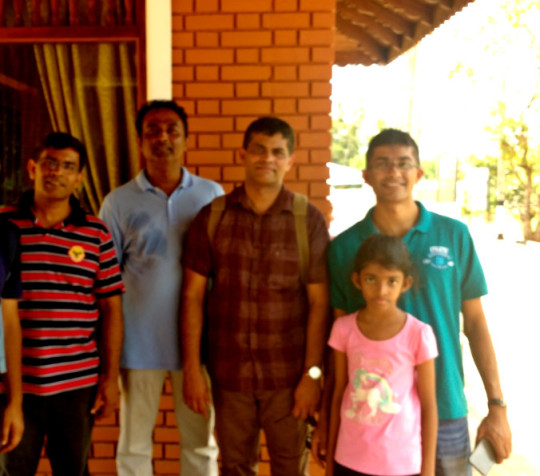
The tuk-tuk driver left me outside the Royal Park – Ranmasu Uyana. This place gave me shade from the scorching heat of the sun.
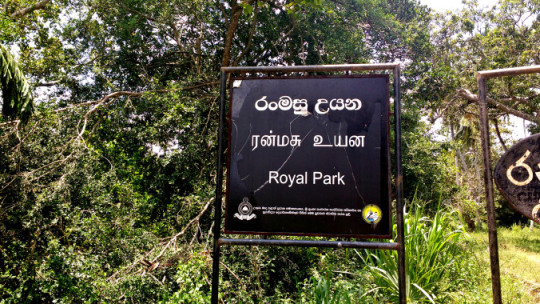
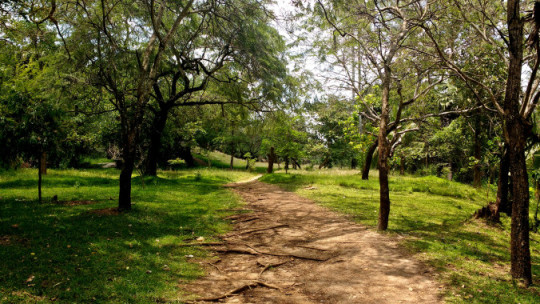
This place has a rich history of the Senegalese empire. The ruins were once an ancient play area for the kings who ruled the country. Depicting the luxurious facilities and technology used in that era.
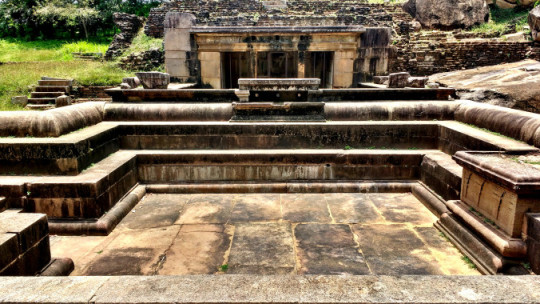
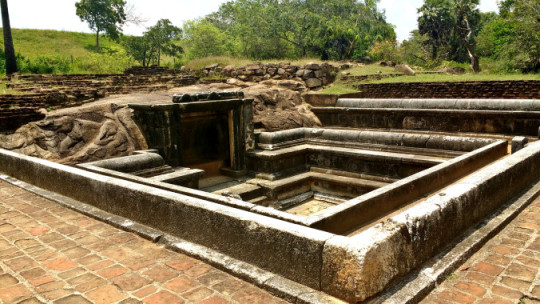
If you are really keen in knowing the history of this place. I would suggest you take a guide.
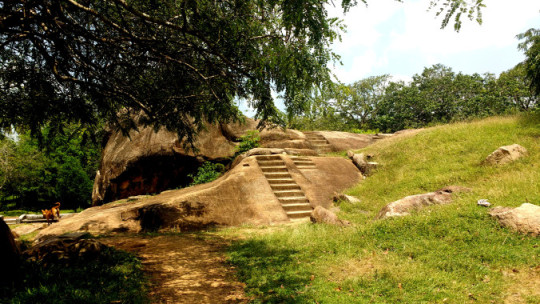
After all the roaming around the ancient city. I asked the tuk-tuk driver to drop me at a pharmacy near the hostel. I purchased the prescribed medicines and returned to the hostel.
In the evening, I left for the Anuradhapura Railway station to purchase tickets for my travel to Jaffna and a return ticket to Colombo from Jaffna. The ticket counter operates from 4 AM till midnight.
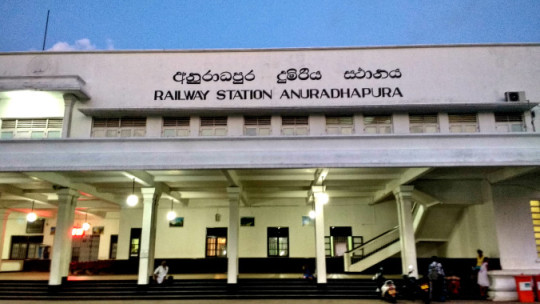
While returning from the Railway Station, I went to this Chinese Restaurant for dinner. Had noodles and ginger beer. Returned to the hostel, did packing for the next day’s travel. Then, went off to sleep.
Day 13 Expenses – 2850LRK (19$) (a) Accommodation Lion Rest – 1500LRK (b) Tuk-Tuk for going around the city – 1000LRK (c) Entry Fee Isurumuniya Temple – 200LRK (d) Dinner – 150LRK
Day 14 (Anuradhapura – Jaffna)
I left the hostel around 9 AM. There was bus stand nearby, boarded a bus to the Railway Station. Sat at the station waiting for the train for a while.
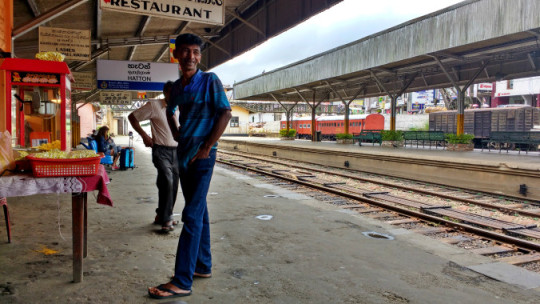
Thankfully, it was an AC train. But there were hardly any people on the train. It seemed not many people were inclined to see this part of the country. Yet, it did not kill my zeal.
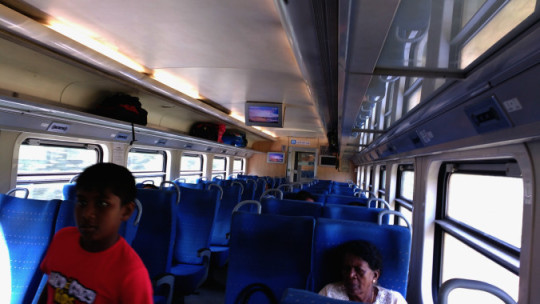
While I was on the train I booked a room at the R&B Guest House, they were providing accommodation at a moderate price and also it was pretty close to the Railway Station. After a 3-hour journey reached Jaffna around noon.
I was picked from the Railway Station by Subraj, the caretaker of the guest house. On our way to the guest house, he told me all the places I can visit. Also, showed a great place to eat.
When he got to know about my knee injury. He offered me to take around Jaffna. As the bus service and other mediums of transport is not as good as in other parts of Sri Lanka.
In the afternoon, first, we went to the Mantri Manai or Residence of the Ministers. I am sure this place had its relevance in the past but now it was in ruins. And none was done by the Archaeological Department for this monument. There was scribbling on the walls and the whole structure was wearing off.


Then, we went to the ‘Jaffna Public Library‘. It opens from 4 PM to 6 PM for visitors. Due to the brevity of time, I did not enter the library. From outside, I could see this beautiful building between the Jaffna Fort and the city centre.
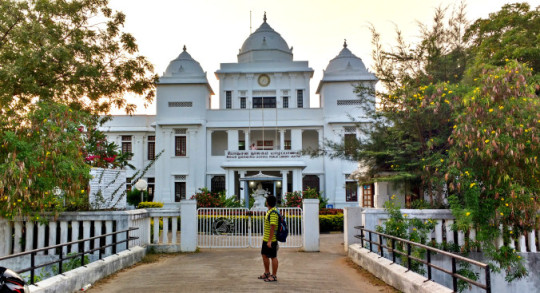
Now, it was the turn of the famous Nallur ‘Kovil Temple’. It is considered as the most sacred temple for the Hindus in Sri Lanka. I was asked to remove my shirt before entering the temple and was not allowed to click any pictures inside the temple. One gets to see the impressive architecture, interesting history and significant devotion. I was on time, so I attended the puja.
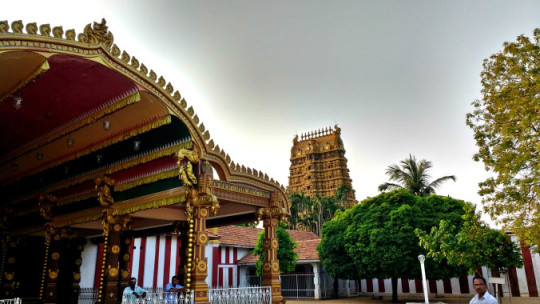
It was almost evening and the sun was about to set. So, Subraj hurried to the Jaffna Fort before it got too dark. He had to leave me at the fort as another traveller had arrived at the guest house. In the meanwhile, I roamed around the deserted fort.
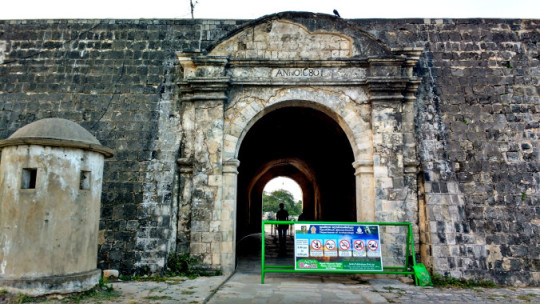
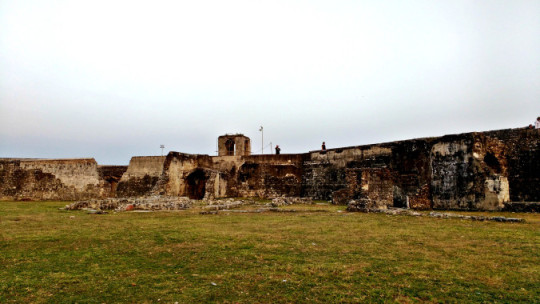
There was no entry fee fort. I roamed around the whole fort. It was sad to see this colonial masterpiece in such a miserable state.
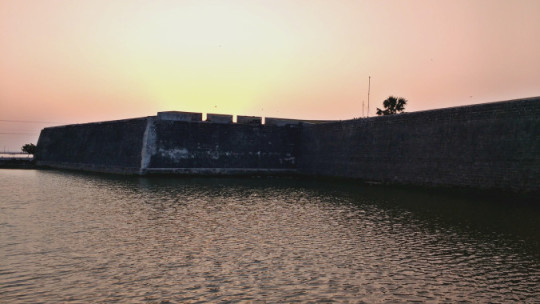
Later, I sat at a corner near the fort waiting for Subraj and also to witness the setting of the sun.
Subraj returned in an hour or so. By this time, I was starving. I asked him to take me to some Indian Restaurant. Thankfully, there was one – Mangoes India Veg.
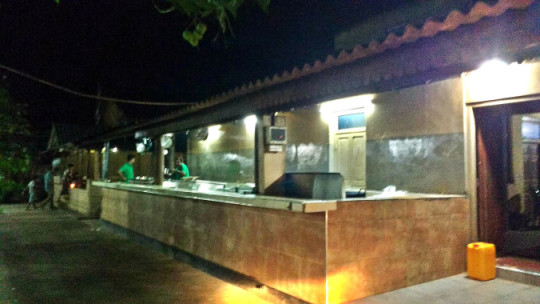
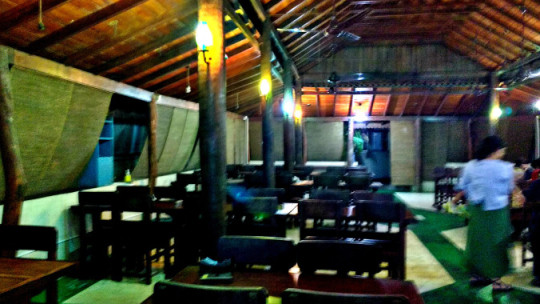
After all the tripping, we went to Mangoes. The food was delicious and inexpensive. Subraj then dropped me at the guesthouse and left for his home.
Day 14 Expenses – 4170LRK (27$) (a) Accommodation Lion Rest – 1750LRK (b) Train from Arunradhapura to Jaffna – 1000LRK (c) Lunch – 500LRK (d) Snacks in the train – 120LRK (e) Dinner – 800LRK
Day 15 Anuradhapura
Next morning, Subraj came with a plan. He wanted to take me to few places. I was dead asleep and woke up when he started banging my room’s door. He told me that he would be taking me to a beach and a U-shaped sacred pool. I got ready and we headed for the day trip.
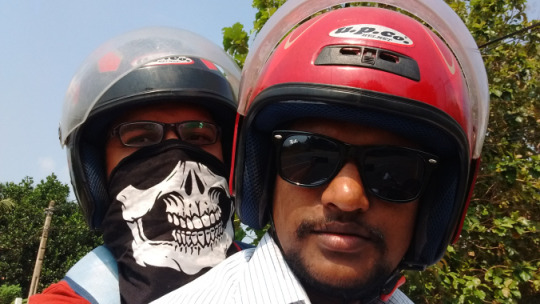
We headed for the beach first, it took good an hour or so to reach the spot. During our ride, I saw Sri Lankan military keeping guard. One could sense the place still recovering from the civil war.
Finally, we reached the KSS or Kankesanthurai Beach. It was the most beautiful beach so far. The water was so clear that I could see the stones at the surface. Another good thing about the place was that there were no people. I was overwhelmed.
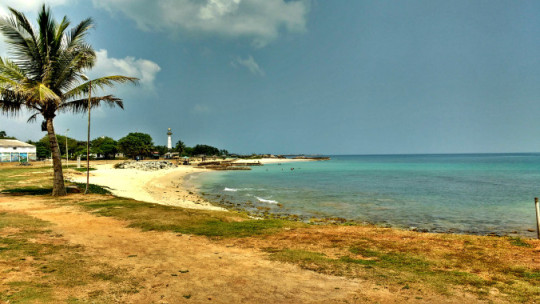
I swam at this clean salty water until I was exhausted. Even my knee pain was reduced due to the upthrust of the water. After a while, few school kids came and we started playing Volleyball with them. I couldn’t understand their language but I knew what they were saying.
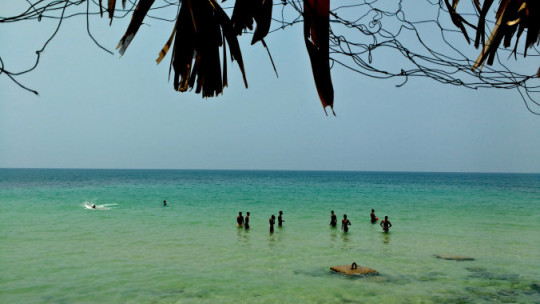
We had spent almost half of the day at the beach. I was all tanned and I skin started to itch, I had suffered a bad sunburn but it did not concern me at all.
Then, we headed to the U-Shaped – Yamuna Eri. The U-Shaped pool is made of carved stones and it is also one of the neglected attractions of Jaffa. There are two similar pools, one of the men and other for the women.
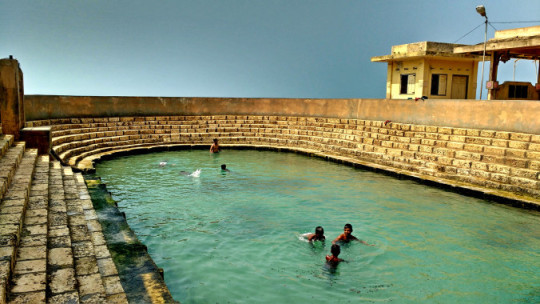
I did swim at the pool but came out of it pretty soon. The place was not maintained that well. I was not comfortable staying in that water. There were huge rocks under the water with algae on it which made the water stink and it was hard to find ground to stand.
It was almost evening and we both were dead tired. Also, we were famished by now. So, I asked Subraj to take me to Mangoes again for dinner. After returning to hostel, I went off to bed and slept like a baby 🙂
Day 15 Expenses – 2550LRK (17$) (a) Accommodation Lion Rest – 1750LRK (b) Gasoline for Bike – 300LRK (c) Dinner – 500LRK
Day 16 Jaffna – Colombo – New Delhi
In the morning I left around 9 AM from the guest house to the Railway Station. Subraj came early to do his regular chores with that he wanted to drop me to the Railway Station.
It was a long tiring journey. And, there was no one in the train compartment in which I was travelling, therefore it turned monotonous too. It took good 8 hours or more to reach Colombo from Jaffna.
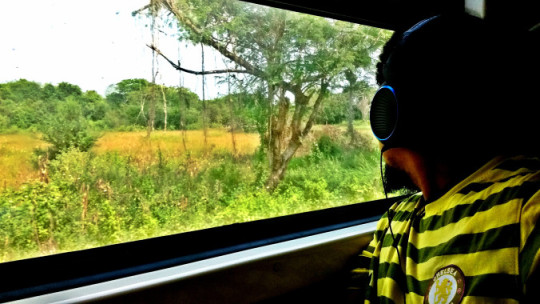
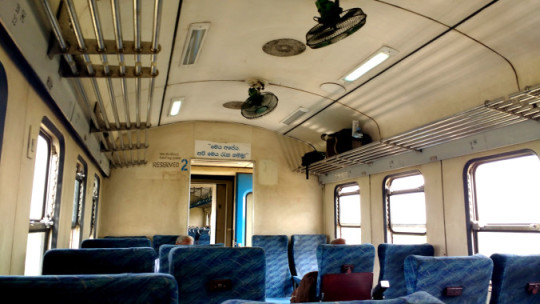
After reaching Colombo. I boarded the bus No.187 for the airport. I reached airport around 10 PM which was too early. My flight was scheduled for 4 AM, I had good 6-7 hours in hand. I wanted to sleep but there was no place to sit. So, I laid on the floor and slept till I was woken up by airlines officials.

And finally, I reached New Delhi at noon 🙂
Hope you guys enjoyed my journey. I have made a video of my travel. If it interests you please like, comment and subscribe to my channel. Would really appreciate it!
Soloed Sri Lanka in 15 days under 500$ Official Blog: www.bornomadic.com Isn't it true that everyone wants to travel? Yes, but money plays an important role in making this decision.
0 notes
Text
My parents were avid travellers. My sister and I grew up listening to their travel stories. Gwalior was one such place, whose stories were part of our childhood. Our fascination grew year by year by listening to their tales. Therefore, we decided to visit Gwalior in March 2018 and explore the city ourselves!
A little bit about Gwalior city
Gwalior is a city of India’s second-largest state, Madhya Pradesh. The city is home to one of the most beguiling forts in India. This fort is also known as the ‘pearl of fortresses’. Many dynasties ruled this city. The Kachwaha, Tomars, Mughals, Marathas and Scindia. It is also the birthplace of one of the nine jewels of Emperor Akbar’s court, Tansen.
Being close to Delhi, Gwalior fits perfect as a weekend getaway destination. Here is a complete itinerary of what we did on our weekend trip to Gwalior.
Day 1 – 6:00 a.m. – Train to Gwalior from Delhi
There are plenty of trains running between Delhi and Gwalior. You can also reach here by car. It takes merely 3.5 hours to reach Gwalior to Delhi. The best train to reach Gwalior is Habibganj Shatabdi Express that starts from New Delhi (NDLS) at 6 a.m.
Boarding an early morning train during winters is an adventure altogether. Although the station was barely 10 km away from our home, it felt like miles apart. It was 5:15 a.m., and we were still struggling to find a ride until the station. Thanks to the local auto-rickshaw drivers, we reached the platform at a margin time and were able to board the train.
Learning: Always pre-book a cab for your early morning travels.
10:30 a.m. – Gwalior Fort Expedition
We stayed at Hotel Ramaya in Gwalior, which was just 1.6 km away from the railway station. We reached the hotel at 10 a.m. packed our gear and left for the day.
The hilltop fort of Gwalior greets you as soon you enter the city. Undoubtedly, the most imposing structure dominating the architecture of Gwalior city. The fort is an excellent example of Hindu architecture and is a must-visit if you’re a first-timer in the city. It is 3 km long enclosing three temples, six palaces, two archaeological museums, numerous water tank and a Gurudwara.
You either can walk from the main fort gates or can take your car inside until the parking. We took the tickets from the counter next to the parking and began our expedition. It took us 3.5 hours to see every bit of it.
2:30 p.m. – Dining at the Mansingh
Even in March, the sun was harsh enough to make us feel dehydrated. Therefore, to save some energy, we took an e-rickshaw ride until the main gate. Getting a cab was a pain as the signals were weak on the fort. However, we managed to grab an auto to the DD Mall.
After all that walk, it was now time to re-energise with some delicious food. I referred to the TripAdvisor App for picking my restaurant. Mansingh was one of the highest-ranking in the city. We tried their famous Tandoor platter, which was worth every penny.
We headed back to the hotel to rest before hopping to our next destination.
7:30 p.m. – Digging out History at the Light and Sound Show
The Light and Sound show happens at the Man Mandir Palace amphitheatre (Gwalior fort) every evening. The show runs in two languages, Hindi (7:30 p.m.) and English (8:30 p.m.).
The show took us through the history of the fort and the love story of Raja Man Singh and his queen Mrignayani. The show was mesmerising and one of the best that I have seen. Moreover, the hilltop view of the city post-show was the icing on the cake.
Right after the show, we tried to book a cab. However, due to weak signals, we were unable to do so. Moreover, there were no transport available until the main gate. Hence, we had to walk for 1.5 km, which was a little creepy and unsafe!
Learning: Pre-book your ride if you are heading to the show.
10:00 p.m. – Dinner at the hotel
We were too exhausted to eat out and so we decided to stay back in our room and order food through the room service.
Day 2 – 9:00 a.m. – Starting the day on a spiritual note
It was our second day in Gwalior. We started early after a delicious breakfast (Indore style Poha) at the hotel.
Our first stop of the day was a replica of the famous Sun Temple in Konark. The Sun Temple of Gwalior is equally remarkable architecture wise. The magnificent red stone façade shines bright in the daylight. On the other hand, the white marble interiors reflect serenity. Every little carving on the temple wall is a beauty indeed. However, the size is a bit smaller than the actual one.
10:30 a.m. – Tomb of Mohammed Ghaus and Tansen
The Tansen road of Gwalior is home to two of the famous tombs of Gwalior, Tomb of Mohammed Ghaus and Tomb of Tansen. Finding these tombs were a bit of a struggle. As the location shown on the map is 500 metres away from the actual tomb entrance. Nevertheless, we were able to locate the tomb with the help of the locals.
The architecture of this mausoleum is unique with hexagonal minarets. The tomb of Tansen, on the other hand, is a simple pillared gallery. Next to which lies a tamarind tree whose leaves are considered sacred by the credulous singers.
11:15 a.m. – A short detour to Moti Mahal
I came across this place while I was finalising my itinerary. However, due to on-going restoration work, we were not allowed inside. We stopped by for few pictures before heading to the Jai Villas Palace.
11:40 a.m. – Jai Villas Palace
Located in the heart of the city is one of the glorious building of Gwalior. Home of the Maharaja of Gwalior. The architecture is a perfect blend of Tuscan, Italian and Corinthian styles. Before entering the palace premises, we stopped by the cafeteria to replenish our energy.
We started with the main museum that comprised of antiques and the preserved pictures of the royal family. We saw the private chambers and other areas of the palace like the private bath, dining and many more. It took us 2.5 hours to see the place.
3:00 p.m. – Lunch at Usha Kiran Palace
I usually prefer eating at a local food outlet than in fine dining, to understand the real essence of the place. However, Usha Kiran Palace was hard to resist. I was intrigued by its history and architecture. And so we decided to grab our lunch at the Silver Saloon Restaurant in Usha Kiran Palace.
4:30 p.m. – Amma Maharaj ko Chhatri (Cenotaph)
Our final spot for the day was the royal memorial ground of the Scindia rulers. This place was about a kilometre away from the Jai Vilas Palace. The ambience was calming and pleasant because of the lush green surroundings. We sat here for a while admiring the architecture and the calmness, before heading back to our hotel.
6:42 p.m. – Heading back home
We took the 6:42 p.m. Rajdhani express from Gwalior railway station and reached Delhi at 10:40 p.m.
Gwalior is a city that is architecturally brilliant and culturally rich. If you wish to visit this place, then follow the above itinerary to make the most of your trip.
Tip: The best time to visit the city is between November and March.
48 Hours in Gwalior: Stay, Explore & Eat My parents were avid travellers. My sister and I grew up listening to their travel stories. Gwalior was one such place, whose stories were part of our childhood.
0 notes
Link
Better Payload Capacity
If the looks impress you, try and see its performance, with a high loading capacity and low maintenance, it has the potential of serving many tasks.
Cost Effective
Renowned for its efficiency in low running cost and low maintenance cost, the MAC Junk is a non-compromising solution to collect waste.
Waste Segregation Facility
A unique solution to segregate waste with two compartments for wet and dry waste collection.
#electric loader rickshaw price#electric loader vehicle#mahindra e rickshaw loader price#old e rickshaw loader#e rickshaw loader olx#electric loader price#bajaj e rickshaw loader price#e rickshaw loader price in india#avon e rickshaw loader#electric loader rickshaw pakistan#electric loader rickshaw price near faridabad haryana#e rickshaw loader price near me#second hand e rickshaw loader in delhi#e rickshaw loader price delhi#electric garbage vehicle chennai#garbage truck electric vehicle#electric garbage collection#electric garbage vehicle price#electric garbage vehicle in india#e rickshaw for garbage collection price
0 notes
Text
electric vehicles: India has more e-rickshaws than China’s e-vehicles fleet
NEW DELHI: An electric-vehicle revolution is gaining ground in India, and it has nothing to do with cars.
The South Asian nation is home to about 1.5 million battery-powered, three-wheeled rickshaws – a fleet bigger than the total number of electric passenger cars sold in China since 2011. But while the world’s largest auto market dangled significant subsidies to encourage purchases of battery-powered cars, India’s e-movement hardly got a hand from the state.
Rather, drivers of the ubiquitous three-wheelers weaving through crowded, smoggy streets discovered that e-rickshaws are quieter, faster, cleaner and cheaper to maintain than a traditional auto rickshaw. They also are less strenuous than cycle rickshaws, which require all-day peddling. So with more rides possible in a day, the e-rickshaws are proving more lucrative.
As many as 11,000 new e-rickshaws hit the streets every month, and annual sales are expected to increase about 9 per cent by 2021, according to consulting firm A.T. Kearney. Three-wheeled vehicles make up a $1.5 billion market, and manufacturers of electric versions include Mahindra & Mahindra Ltd and Kinetic Engineering Ltd, along with smaller outfits that assemble parts imported from China.
“This is a once-in-a-lifetime, transformational opportunity that we’re looking at,” said Goldie Srivastava, chief executive officer and co-founder of SmartE, an Uber-style app using 800-plus e-rickshaws around New Delhi. “When we look at electric mobility, the focus should be: Are you as a government enabling products that are designed for the future?”
India’s dominant ride-hailing startup, Ola, plans to place 10,000 e-ricks in its service by next April.
India is the world’s fourth-largest auto market, but previous attempts to boost private electric-car ownership flopped. The government likely scaled back because it fears disrupting an industry that contributes about 7 per cent of the total gross domestic product, according to a Bloomberg NEF report in March. Unlike the estimated 1.35 million passenger EVs cruising around China, the number of electric cars plying Indian roads is a paltry 6,000, according to BNEF data. Chinese automakers sell more than that in three days.
India’s largest automaker, Maruti Suzuki India Ltd, won’t sell its first EV until 2020.
Prime Minister Narendra Modi’s administration now is pivoting toward promoting EVs in public transportation and fleet operations – primarily, two- and three-wheelers, taxis and buses. The ministry of finance is finalising a plan to spend about Rs 4,000 crore ($600 million) in the next five years to improve the nation’s charging infrastructure and subsidize e-buses.
“India needs to focus on electrifying two-wheelers and three-wheelers,’’ said Amitabh Kant, chief executive of NITI Aayog, a government policy institute helping formulate the new strategy.
Outside an east Delhi metro station, a slew of partly open-air vehicles line the street as commuters hail their rides. They also carry tourists, schoolchildren, crates of fruit and the occasional goat.
Anil Chaudhary, 32, switched to an e-rickshaw from a cycle model two years ago. His income increased, he’s able to take longer breaks and he sends money to his wife and three children in Bihar, about 700 miles away. He’s already on his second electric model.
“Two months ago, I called my brother from the village and gave him my old e-rickshaw so that he could drive it,’’ he said as a goat strolled past.
“I’ve bought this new one,” he said, gesturing toward a glossy, red vehicle adorned with paper flowers and an Indian flag.
Then there’s the ameliorative effect that e-ricks have on the toxic air in India, home to 10 of the world’s most-polluted cities, according to the World Health Organization. A total of 635,698 three-wheel vehicles were sold during the fiscal year that ended in March – a 24 per cent increase from a year earlier, according to the Society of Indian Automobile Manufacturers. By comparison, about 3.3 million passenger cars were sold, mostly all powered by gasoline or diesel.
One hindrance to the potential growth of EVs is the lack of charging and battery-swapping stations nationwide. India had about 425 publicly available charging points at the end of last year. By 2022, government and private efforts are expected to boost that to an estimated 2,800 charging points, according to BNEF.
Instead of waiting, some companies are starting to build their own infrastructure. SmartE partnered with Delhi Metro Rail Corp. to provide charging near 10 stations, with plans to expand throughout the 214-station system by the end of 2020.
Another hindrance is the lack of bank financing for traditional rickshaw drivers, who typically earn low incomes, said Shishir Agrawal, managing director of Shigan eVoltz Ltd, the parent company of manufacturer GreenRick.
The Gurgaon-based company, which sells e-rickshaws mostly in Delhi and Uttar Pradesh, could more than triple production to 1,000 vehicles a month if that issue was resolved. The potential market for e-rickshaws could be sales of 20 million vehicles a year, he said.
“If the subsidies get better, and easy financing options become available, this market is unstoppable,” Agrawal said.
The post electric vehicles: India has more e-rickshaws than China’s e-vehicles fleet appeared first on Watch Online Pakistani Dramas.
from Watch Online Pakistani Dramas https://ift.tt/2EM5Gv5 via IFTTT
0 notes
Text
Benefits of Electrical Vehicles |Delta AutoCorp LLP
Proliferation of Electrical Vehicles Is the Next-Gen Innovative Approach…
The current generation is unaware of a transformation; a transformation when coal-driven external combustion engines gave way to Petroleum-driven internal combustion engines. A new era of Automobile revolution heralded into the world. People who invested in the proliferation of internal combustion engine have minted money in the market. If you are seeking for an
E-Rickshaw Dealership in Delhi,
then probably you can also mint money, because now we are standing on the verge of an “
Electrical Auto Revolution
.”
2 P’s Benefits of Electrical Vehicles
Profit: First P is "Profit" or the production of the goods that are good for the economy and have a great multiplier in the terms of convenience and profit.
Planet: The second P is the “Planet;” the human race is now looking for some goods and services that are in synchronization with the spirit of the planet and the environment.
In short, PROFIT for the PLANET!
While looking for dealership for electrical vehicles, you are completing both the conditions with great effect. Electrical vehicles are a money-minting option for the producers and user because of their fuel efficiency and they are certainly the best method to protect the environment because they support no emissions.
Gear Up for a Hybrid Vehicle World
While applying for an E-Richshaw Dealership in Delhi makes sure that you are joining the lanes of immediate profit. These lanes will also connect you to the superhighway of profit when the technology of hybrid vehicles will take over. Most of the people living in Delhi are well aware of the impacts of smog. Hybrid vehicles are a great solution to counter the problem of smog in the city. This is why, the dealership for electric vehicles has this power to bring you into a zone where you can tie up with big companies like Delta and enjoy the status of being their networking partners. It is obvious that your investments in the field of electrical automobile solutions will win you a network with a passage of time and you can upgrade yourself big time by introducing new products in an existing pipeline.
The Sentiment of the Government Sector Is Upbeat
We have no official records to prove it; however, based on simple calculations and worldly observations, we can say that E-richshaw dealership in Delhi is a lucrative business. Right now, they are receiving a left-hand support of the government machinery but the time is not far ahead when they will start receiving direct tax rebates and other promotional facilities. The regular automobile industry got a boost at the turn of this century when the government announced the commissioning of roads and highways in India.
Electrical vehicles are going to get the advantage of the infrastructure when they will replace regular automobiles on the roads. It is expected that the industry segment of electrical vehicles will receive tax rebates in the beginning, and in order to discourage regular automobiles, they will impose taxes on them. The time has come when you can change the lanes and change the gears to attain quick profit from the same efforts that you are putting down right now.
0 notes
Text
Budget may make faking input tax non-bailable crime for buyers too
New Post has been published on https://apzweb.com/budget-may-make-faking-input-tax-non-bailable-crime-for-buyers-too/
Budget may make faking input tax non-bailable crime for buyers too

NEW DELHI: The government is likely to make fraudulent claims for input tax credit a non-bailable offence in the hands of recipients of goods and services in the February 1 budget by tightening the GST law, as it seeks to plug leakages.
CXOs, directors or employees directly responsible for making such claims can also be penalised as per the proposed changes aimed at tackling evasion.
“Changes are being proposed to the law to plug issues related to fraud input tax credit,” said a government official. The threshold of Rs 5 crore will apply for the offence being treated as bailable; beyond that it will be non-bailable. The provision already applies to suppliers of goods and services.
GST Council has Okayed Changes The provision is now proposed to be expanded to include recipients found guilty of colluding in such fraud, said the person.
The proposed amendments to Sections 122 and 132 of the GST Act have been endorsed by the law committee and the GST Council, the apex decision-making body for the tax. Current provisions don’t have specific measures to deal with such tax evasion.
“A value-added tax like GST should have explicit penalties to deal with cases where active collusion results in input tax credit frauds,” said MS Mani, partner, Deloitte India. “Such cases by a small community of taxpayers lead to increasing compliance and procedural requirements on all taxpayers.”

Another official said the government has come to the view that beneficiaries of such fraudulent claims, usually made through dummy companies, should be penalised commensurately.
The authorities have registered several cases in which input tax credit has been claimed without supporting invoices or receipt of goods or services. A clear provision in the law will provide a framework for dealing with such cases, the second official said.
An official said the names of daily wage earners such as rickshaw pullers and others are being used to open multiple firms that issue invoices without supply of goods or services to pass on input tax credit. Those who orchestrate such frauds also arrange for actual suppliers of goods or services to whom these invoices will be sold on payment of an agreed amount of money.
These suppliers then utilise this credit to either discharge their GST liability or claim refunds of duty paid on export of overvalued goods, the official said.
The GST Council has also endorsed changes to Section 49 of the GST Act empowering officials to block credit in the case of fraud. This will also be introduced in the budget.
Experts said the changes will need to be elaborated upon to avoid confusion. “While there is a need to have legislative recourse to prevent such instances, it’s important that government issues detailed guidelines as to how and when these provisions have to be invoked so that possibility of misuse can be minimised,” said Pratik Jain, indirect tax leader, PwC.
if(geolocation && geolocation != 5 && (typeof skip == 'undefined' || typeof skip.fbevents == 'undefined')) !function(f,b,e,v,n,t,s) if(f.fbq)return;n=f.fbq=function()n.callMethod? n.callMethod.apply(n,arguments):n.queue.push(arguments); if(!f._fbq)f._fbq=n;n.push=n;n.loaded=!0;n.version='2.0'; n.queue=[];t=b.createElement(e);t.async=!0; t.src=v;s=b.getElementsByTagName(e)[0]; s.parentNode.insertBefore(t,s)(window, document,'script', 'https://connect.facebook.net/en_US/fbevents.js'); fbq('init', '338698809636220'); fbq('track', 'PageView');
Source link
0 notes
Text
What it looks like when 1.3 billion people stay home
New Post has been published on https://apzweb.com/what-it-looks-like-when-1-3-billion-people-stay-home/
What it looks like when 1.3 billion people stay home
By Saritha Rai
On March 24, Indian Prime Minister Narendra Modi ordered the world’s largest lockdown, effectively commanding one out of every six people on earth to stay home in an effort to stem the coronavirus outbreak in the country. The humongous state-run railways recorded the first suspension of services in its 167-year history, and millions of migrant day laborers walked hundreds of miles back to their villages along deserted highways.
With 5,351 infected and 160 deaths, the official toll of India’s caseload is dubiously small—the country had conducted only 128,000 tests as of Wednesday. Lockdown notwithstanding, the country could see as many as 300 million infections with 10 million of them severe, the risks compounded by population density, poor sanitary conditions and a largely decrepit health care system, according to Ramanan Laxminarayan, director of the Center for Disease Dynamics, Economics and Policy in Washington D.C.
Like everywhere else under lockdown, the social and economic impacts have stunned the country. The difference in India is the scale — the sheer number of people who, as they go about their daily lives, create the world’s worst traffic and dirtiest air. And when those people stay home, the reversal is similarly massive. Five technology companies, from an Indian grocery startup to a global online learning giant, provided Bloomberg with data that helps illustrate what happens when 1.3 billion people stay home.
Until last month, it was faster to walk than to drive across India’s most clogged roadways, including the Silk Board in Bangalore, the Ambiance Mall area in New Delhi or the Teen Haath Naka junction in Mumbai, where traffic flows 48 different ways. The now-empty streets are “the most visible macro perspective on the country’s lockdown,” says Rohan Verma, the chief executive officer of MapmyIndia.
Absent the throngs of buses, two-wheelers, rickshaws and hand-drawn carts, birdsong and cleaner air has returned. India was home to 14 of the 20 most polluted cities in the world in 2019, according to IQAir. Only one—Mumbai—was in the top 20 on April 9, 2020. Photos of blue skies and transparent river water circulated on social media, captivating an audience stuck indoors. The shutdown has brought air quality to acceptable levels even in Delhi, which last year was blanketed by such heavy haze that schools were closed and flights couldn’t land, and for the first time in recent history, residents of Jalandhar in the Punjab could see snow-capped Himalayas, some 200 kilometers from the city.
Online grocery shopping is still fledgling in India, though this lockdown is encouraging more people to buy more from sites like New Delhi-based Grofers. The site typically caters to working class clients, and they’re buying the usual pandemic staples — hand sanitizer sales are up nearly sevenfold. But they’re also indulging in pricey natural foods, which cofounder and Chief Executive Officer Albinder Dhindsa said took him aback. “The middle class doesn’t have spare cash to hoard supplies,” said Dhindsa. “So it was surprising to see packets of dry fruits, bottles of honey, and immunity-boosting herbal chawanprash fly out of our warehouses.”
Global shutdowns have put new focus on online learning, and India has 250 million students now home from school. The country is the second-biggest market for pioneer Khan Academy, which offers classes in Hindi, English and the blended Hinglish, as well as Kannada and Gujarati. The site has seen unprecedented growth during the pandemic, and India’s lockdown brought another deluge: registrations by Indian parents are up 1,000%, teacher sign-ups jumped 700%, student accounts by 450%.
In second week of the lockdown, over 627 million people watched an average of 4 hours 48 minutes every day, for a total of 2.4 million years worth of viewing time, according to Nielsen and Broadcast Audience Research Council of India (BARC). At prime time on Sunday, March 29, 51 million tuned into the national Doordarshan channel for Indian television’s “biggest day ever,” according to BARC Chief Executive Officer Sunil Lulla. What was on? A rebroadcast of the 1987 hit serial Ramayan, an adaptation of the ancient Hindu epic Ramayana.
if(geolocation && geolocation != 5 && (typeof skip == 'undefined' || typeof skip.fbevents == 'undefined')) !function(f,b,e,v,n,t,s) if(f.fbq)return;n=f.fbq=function()n.callMethod? n.callMethod.apply(n,arguments):n.queue.push(arguments); if(!f._fbq)f._fbq=n;n.push=n;n.loaded=!0;n.version='2.0'; n.queue=[];t=b.createElement(e);t.async=!0; t.src=v;s=b.getElementsByTagName(e)[0]; s.parentNode.insertBefore(t,s)(window, document,'script', 'https://connect.facebook.net/en_US/fbevents.js'); fbq('init', '338698809636220'); fbq('track', 'PageView');
Source link
0 notes